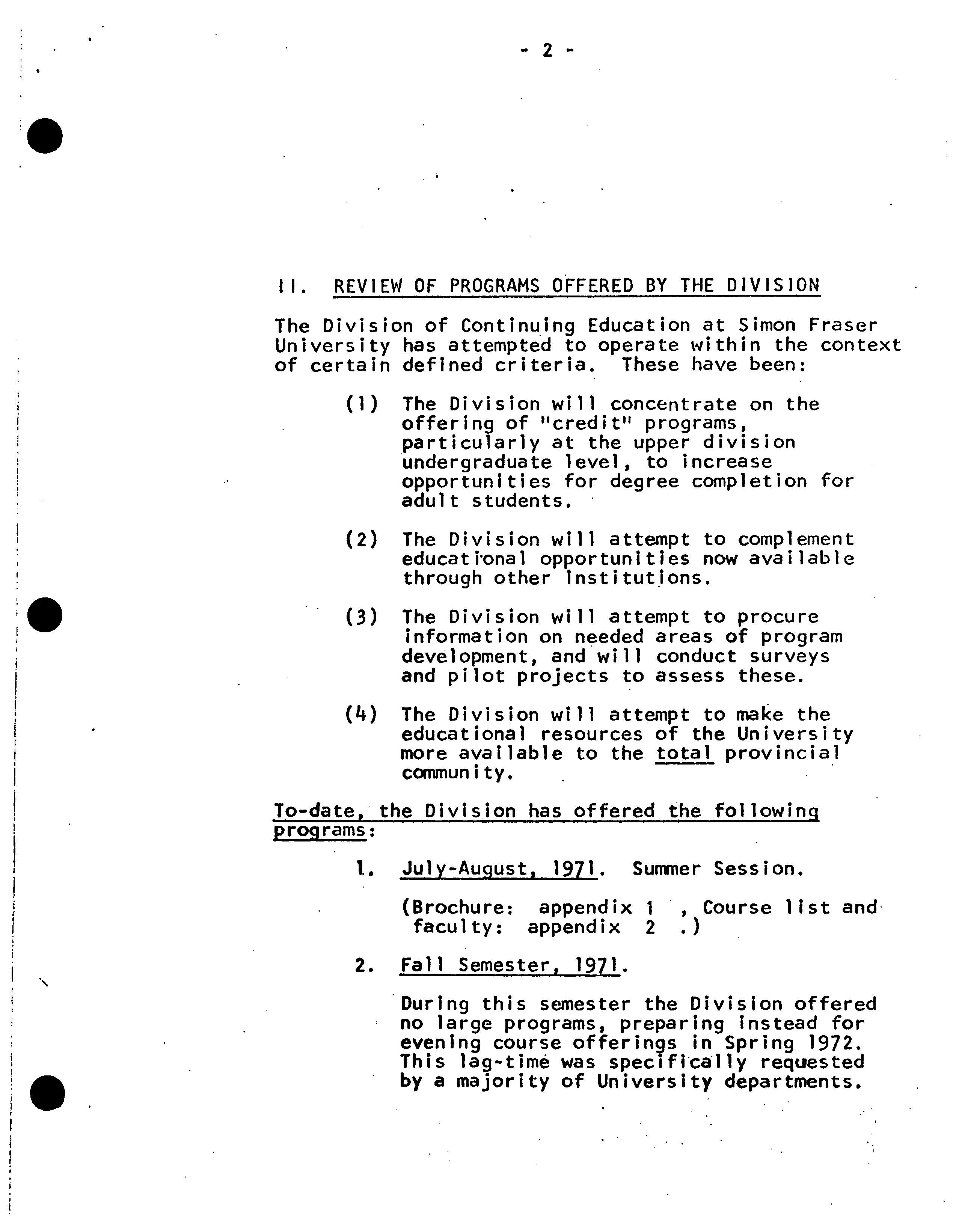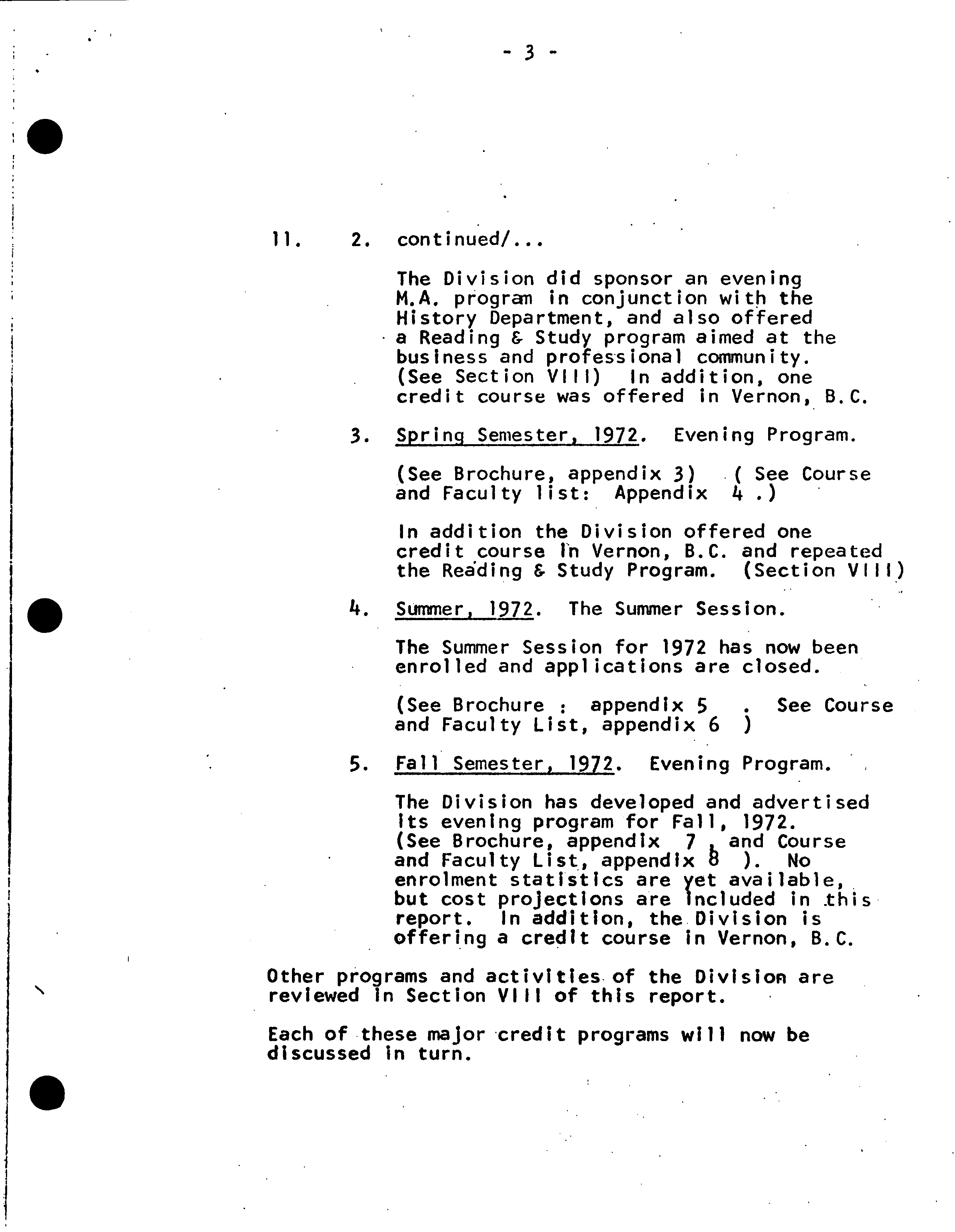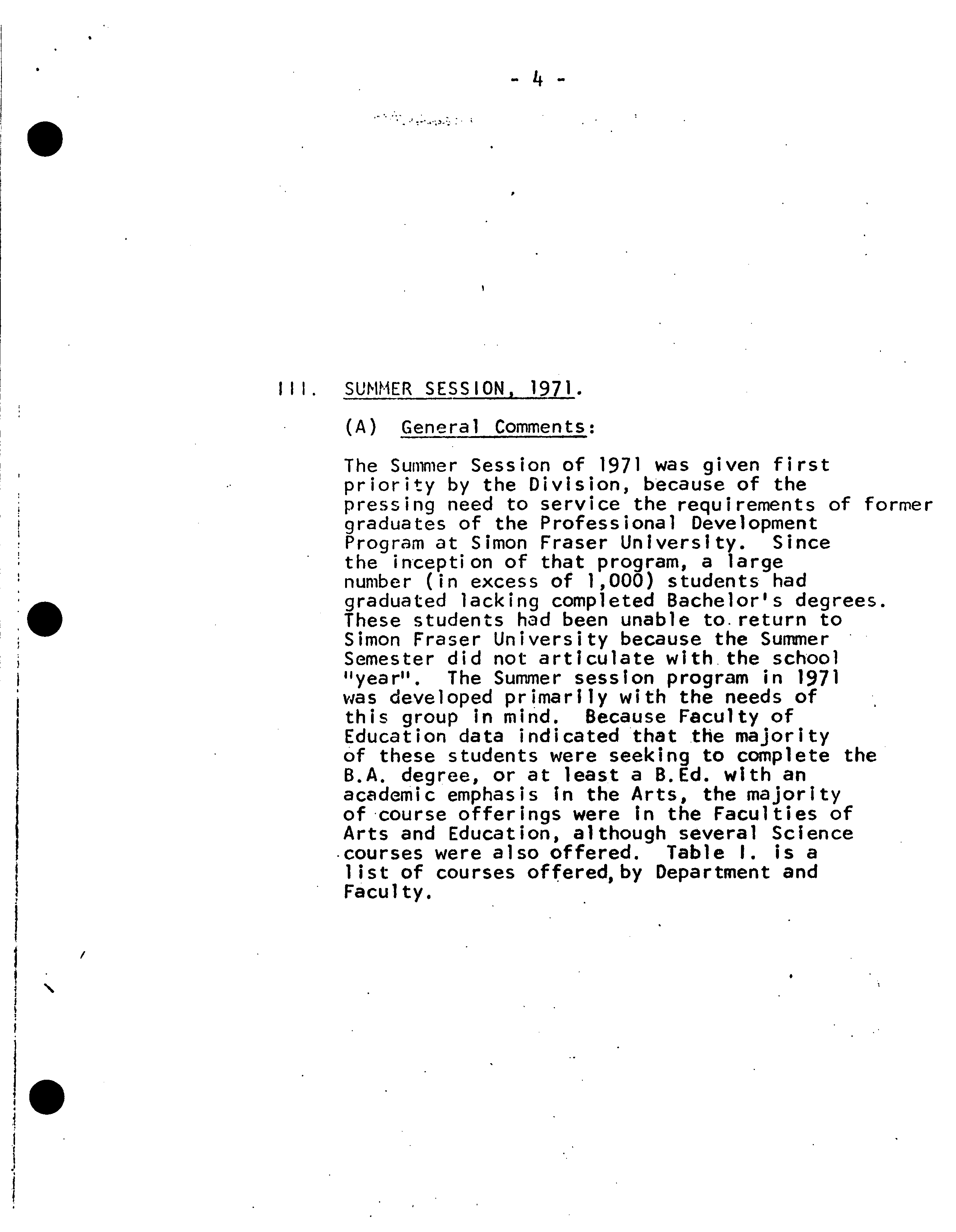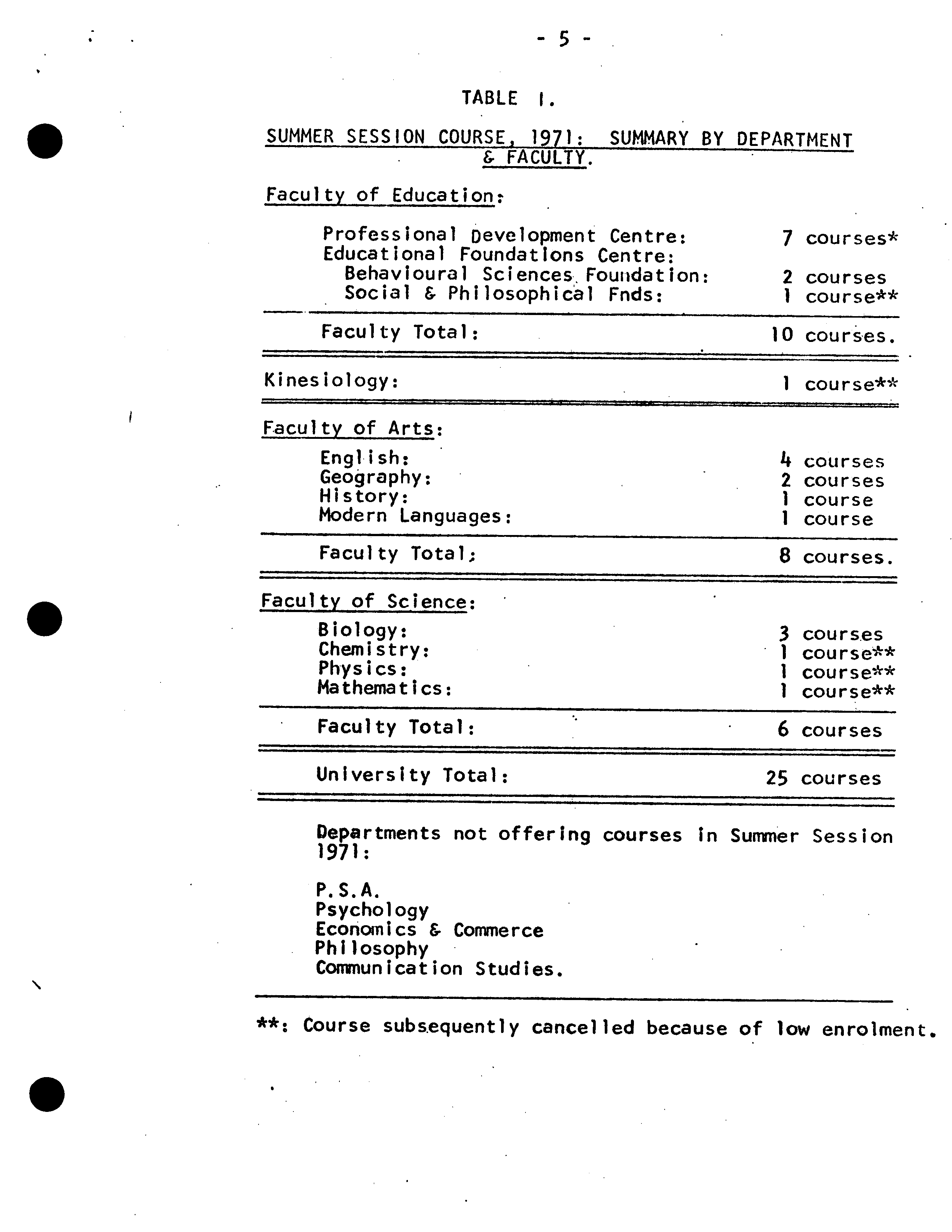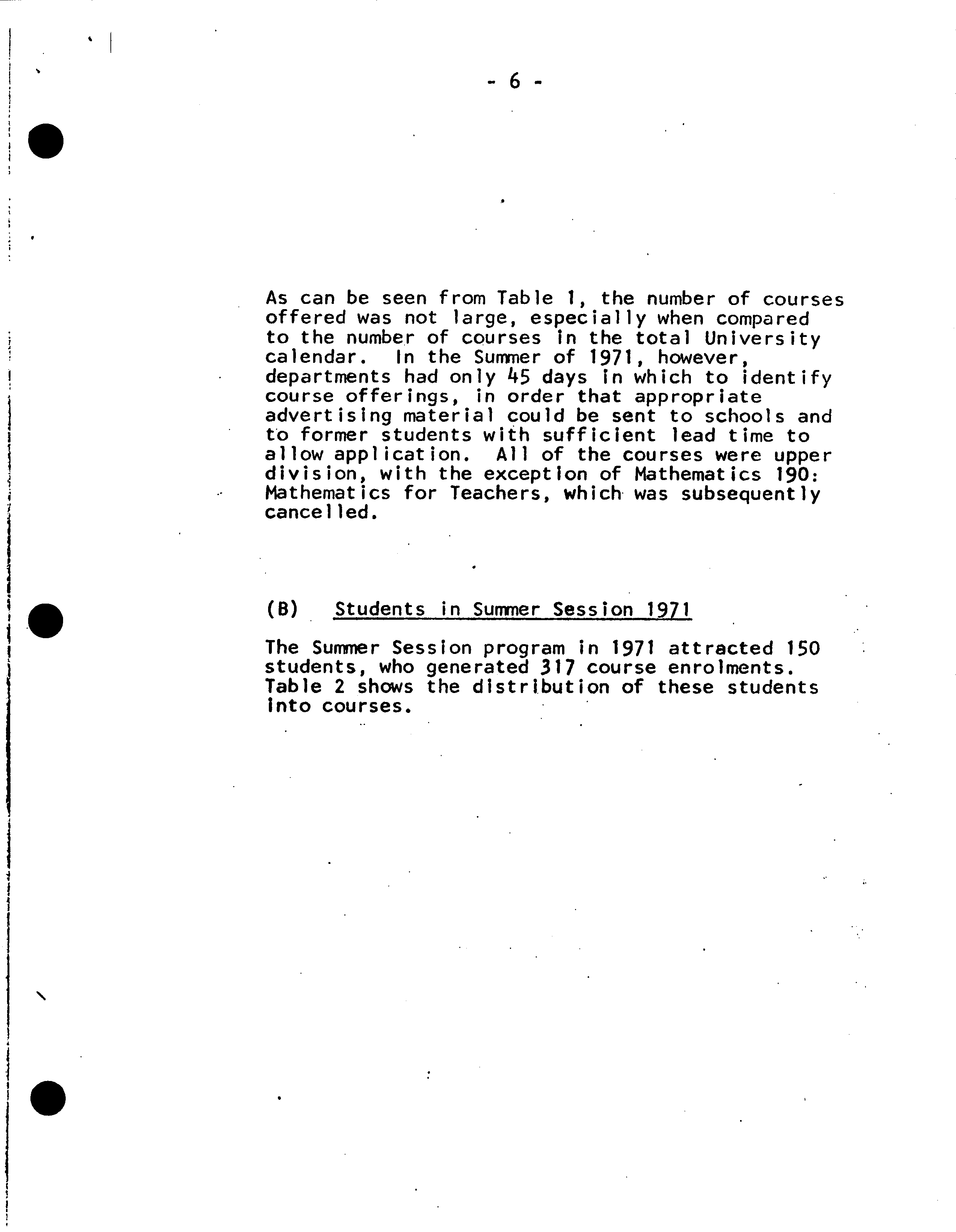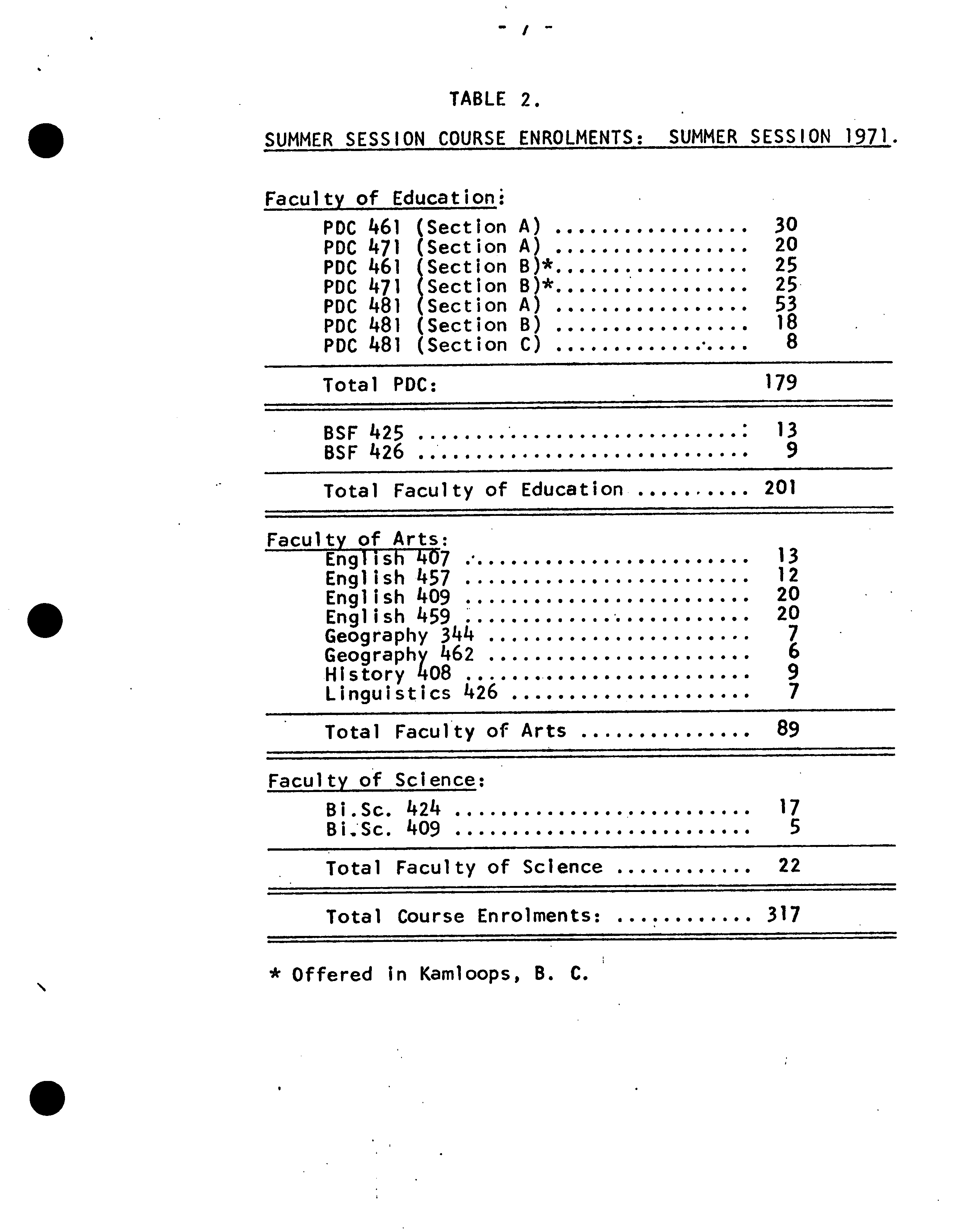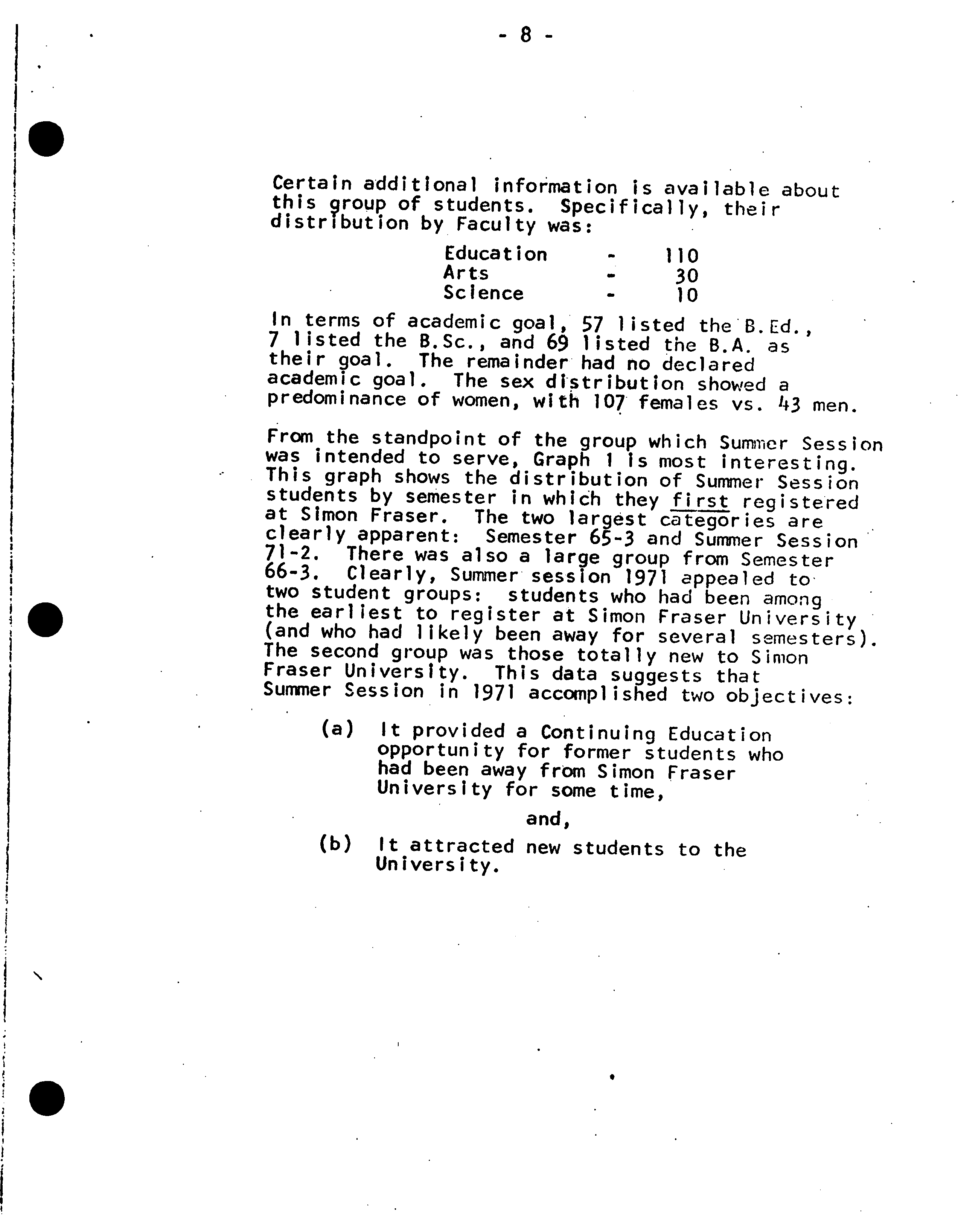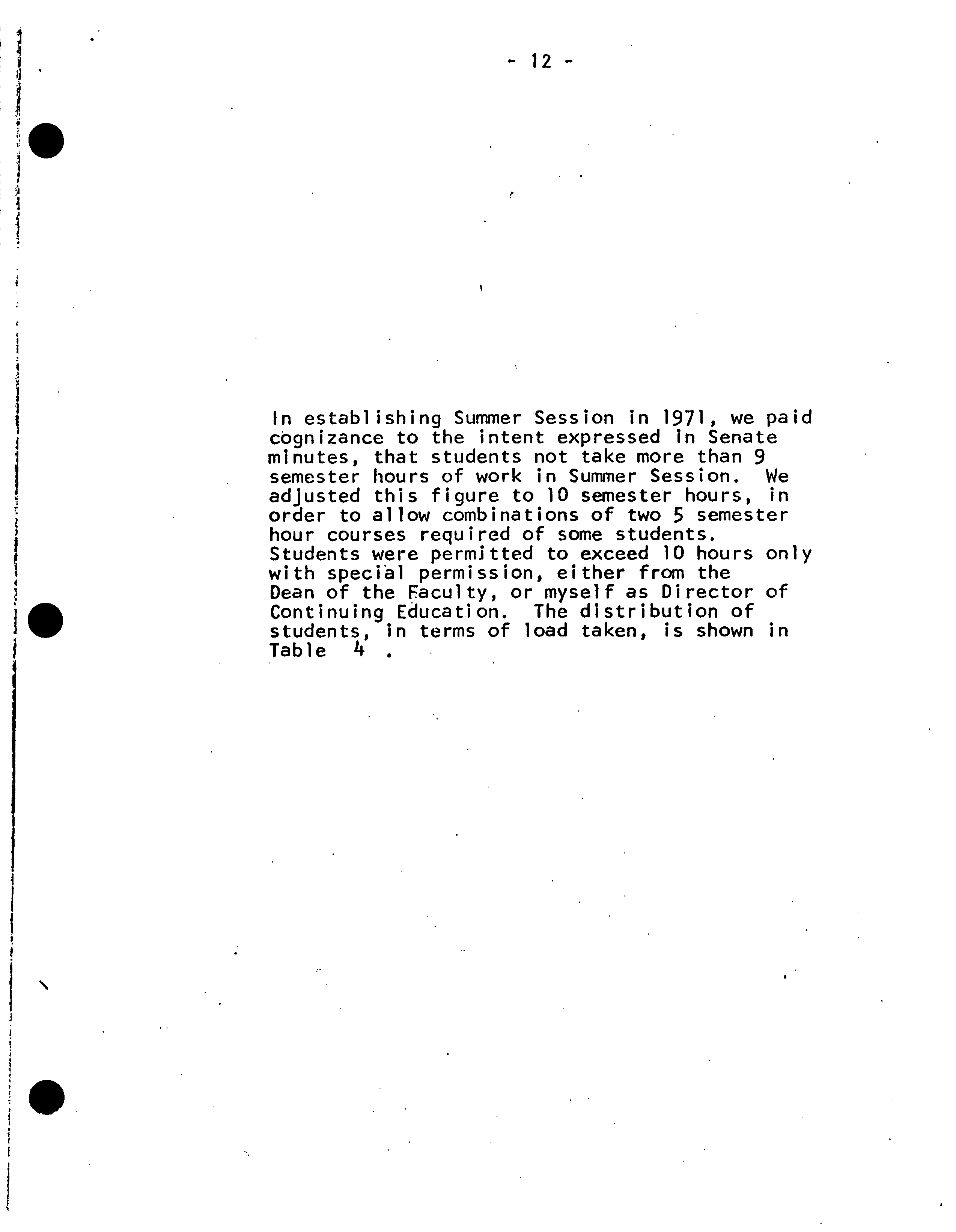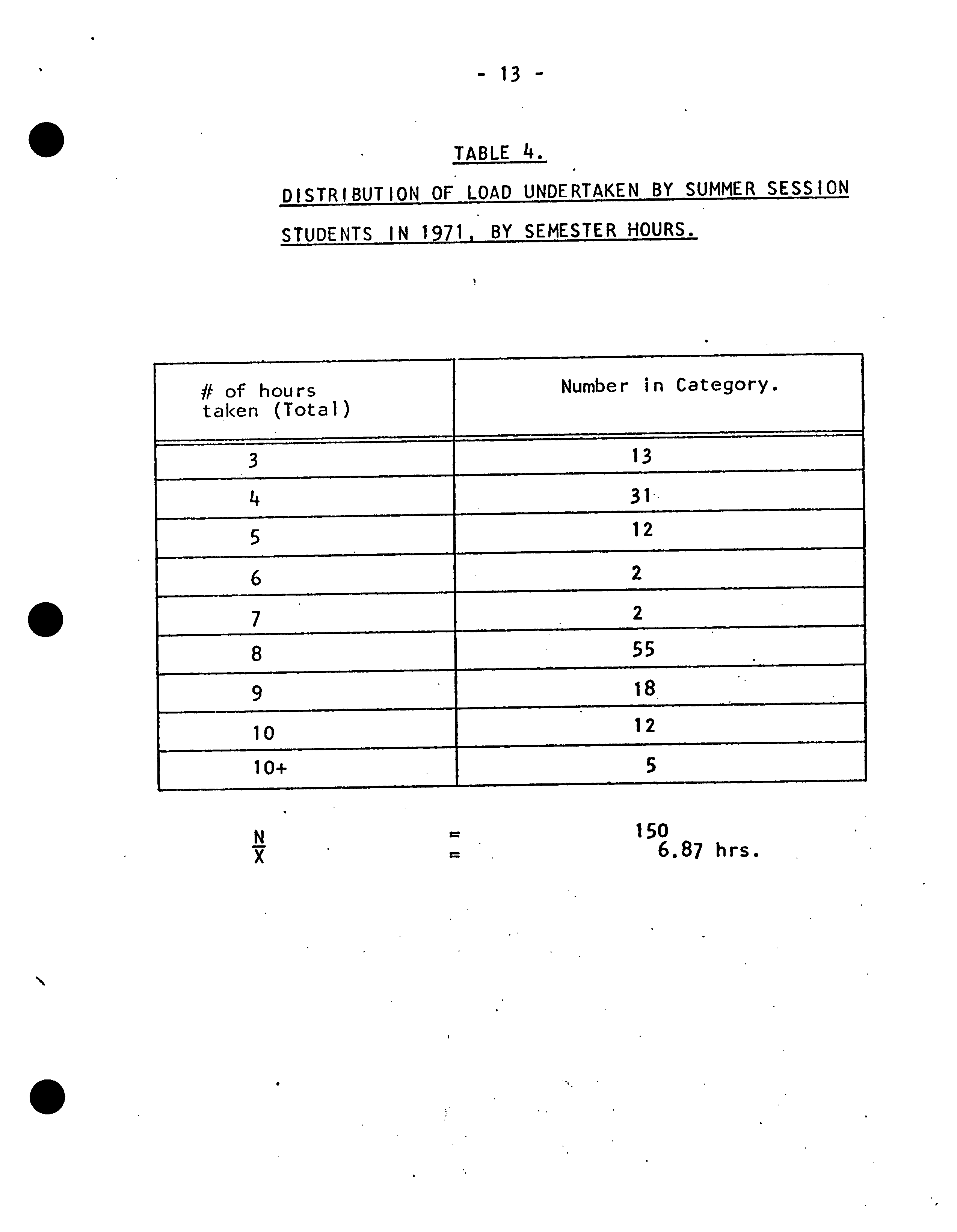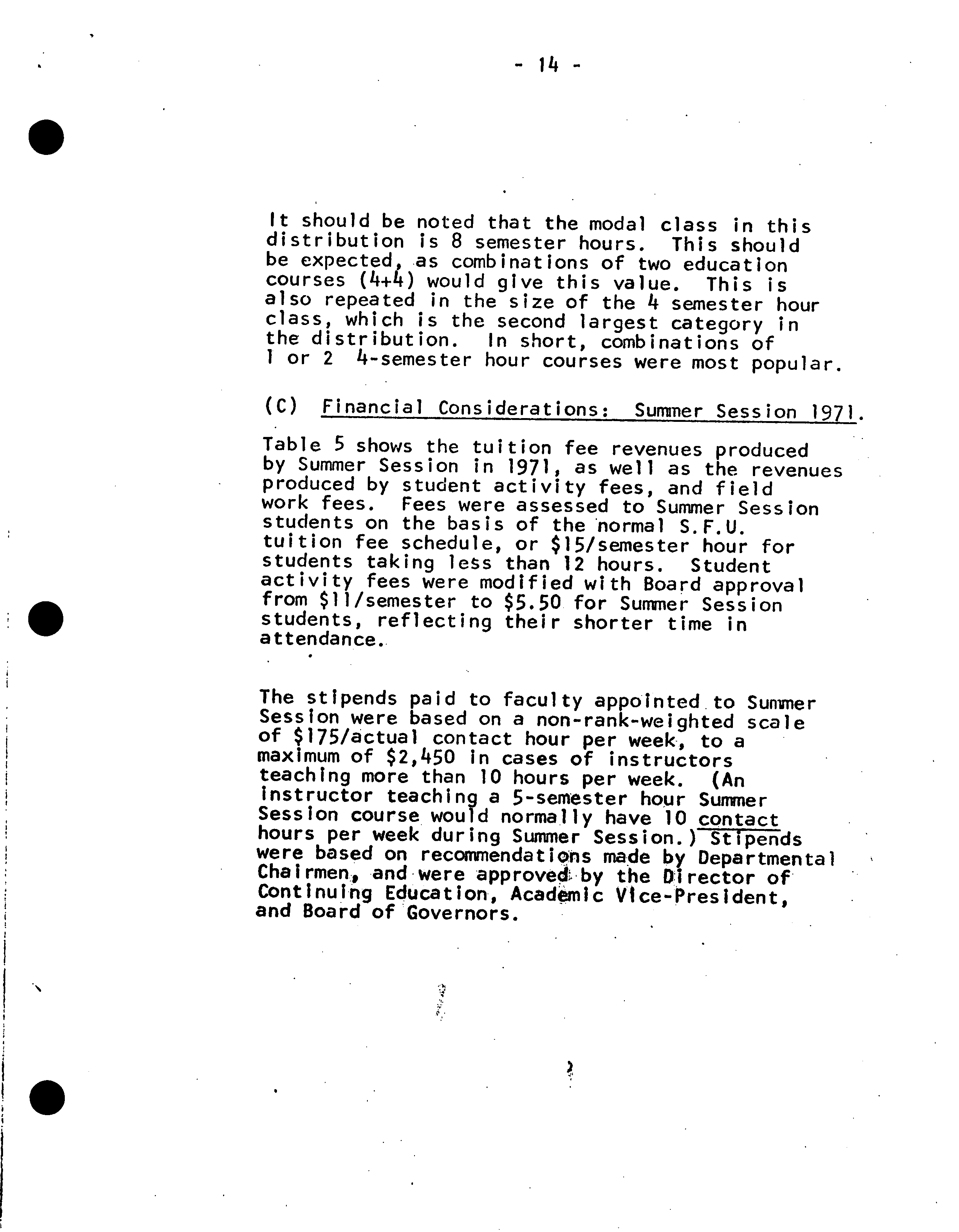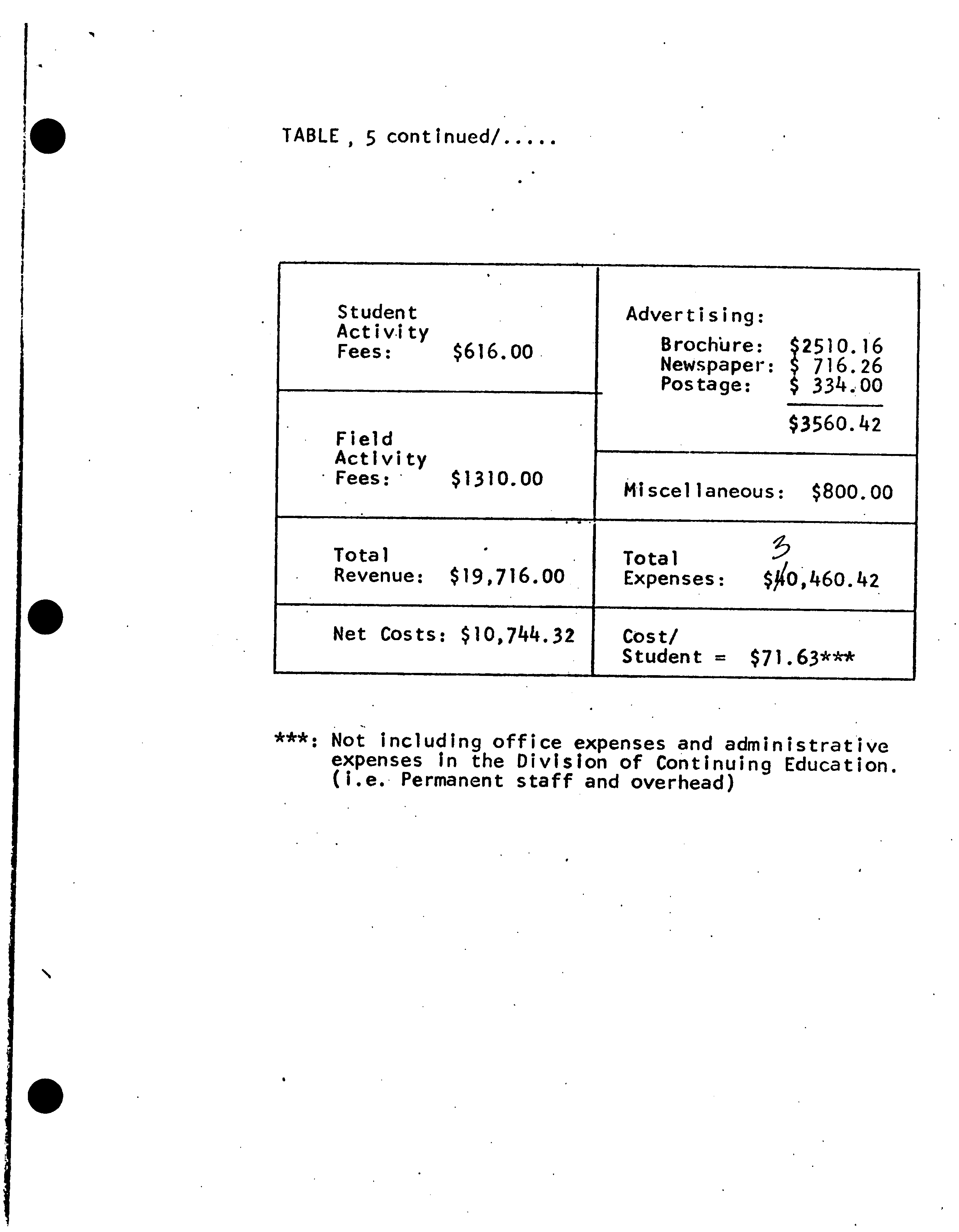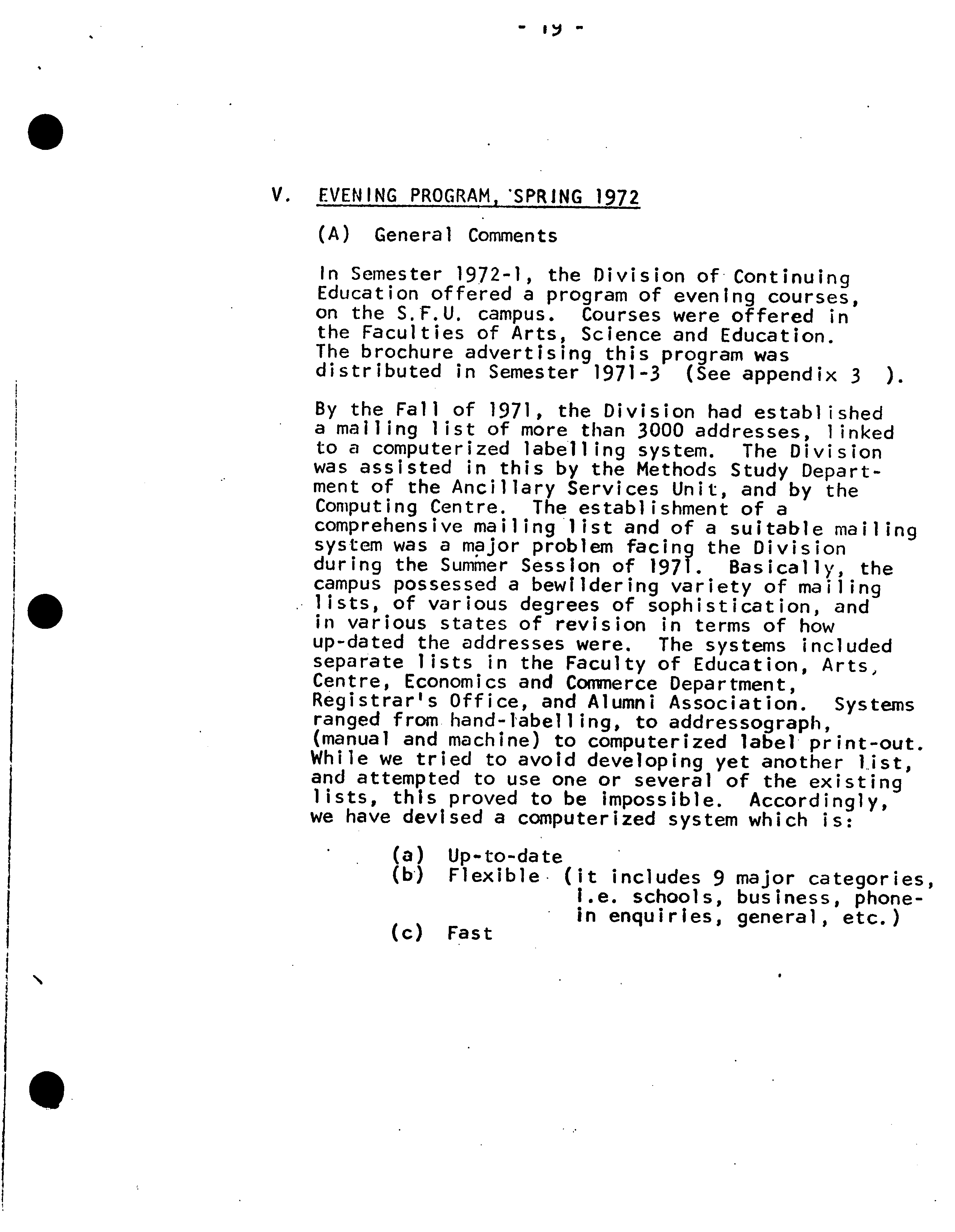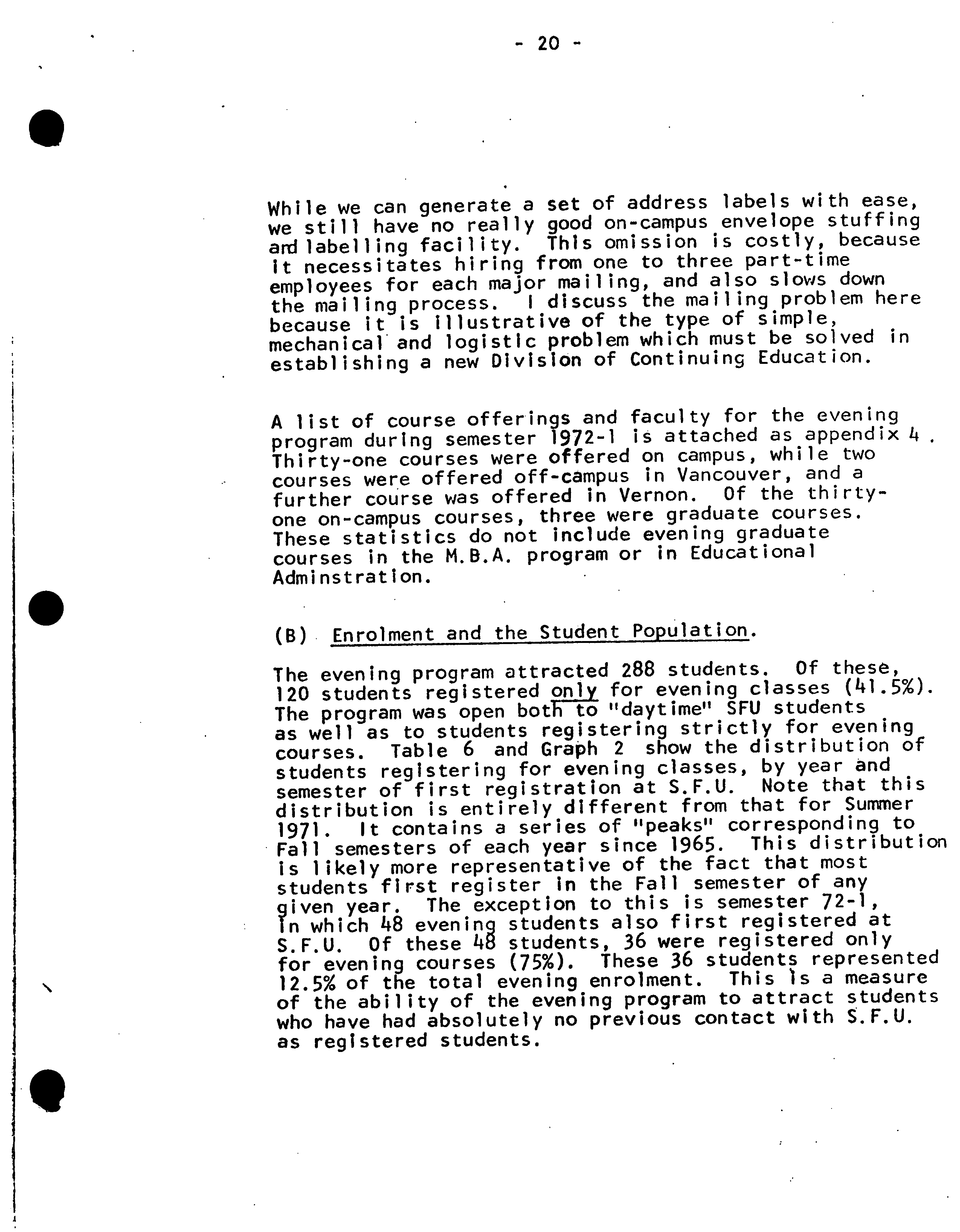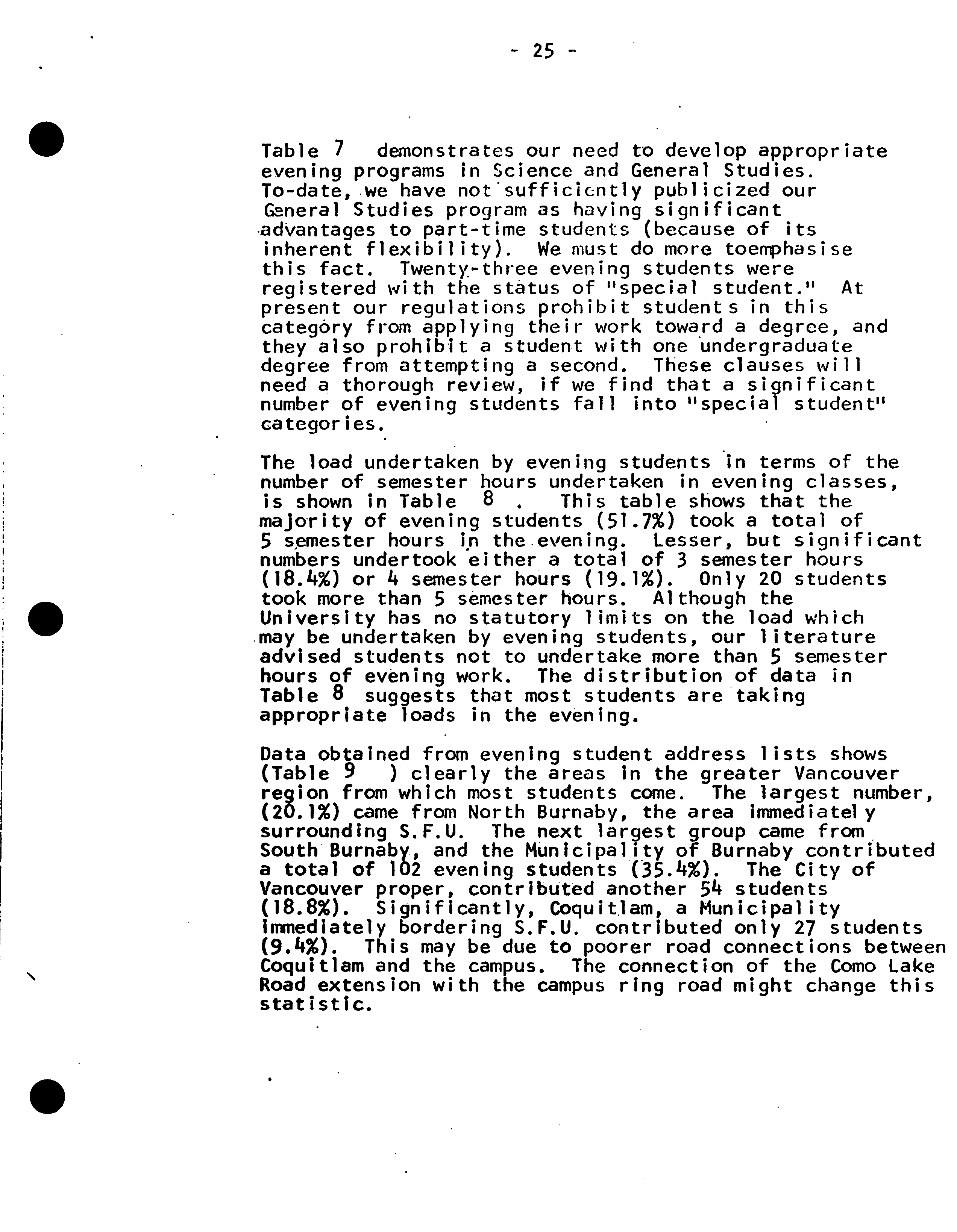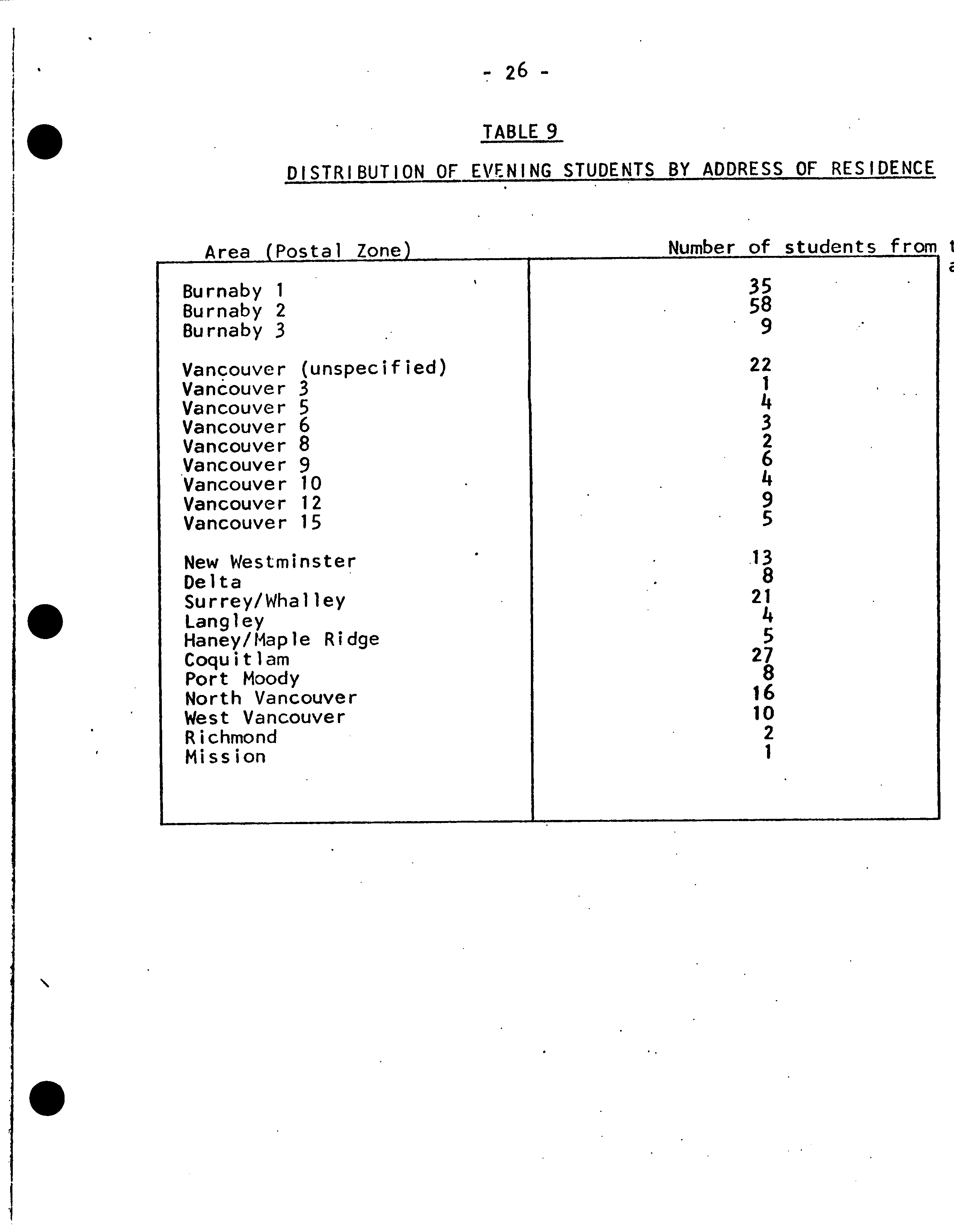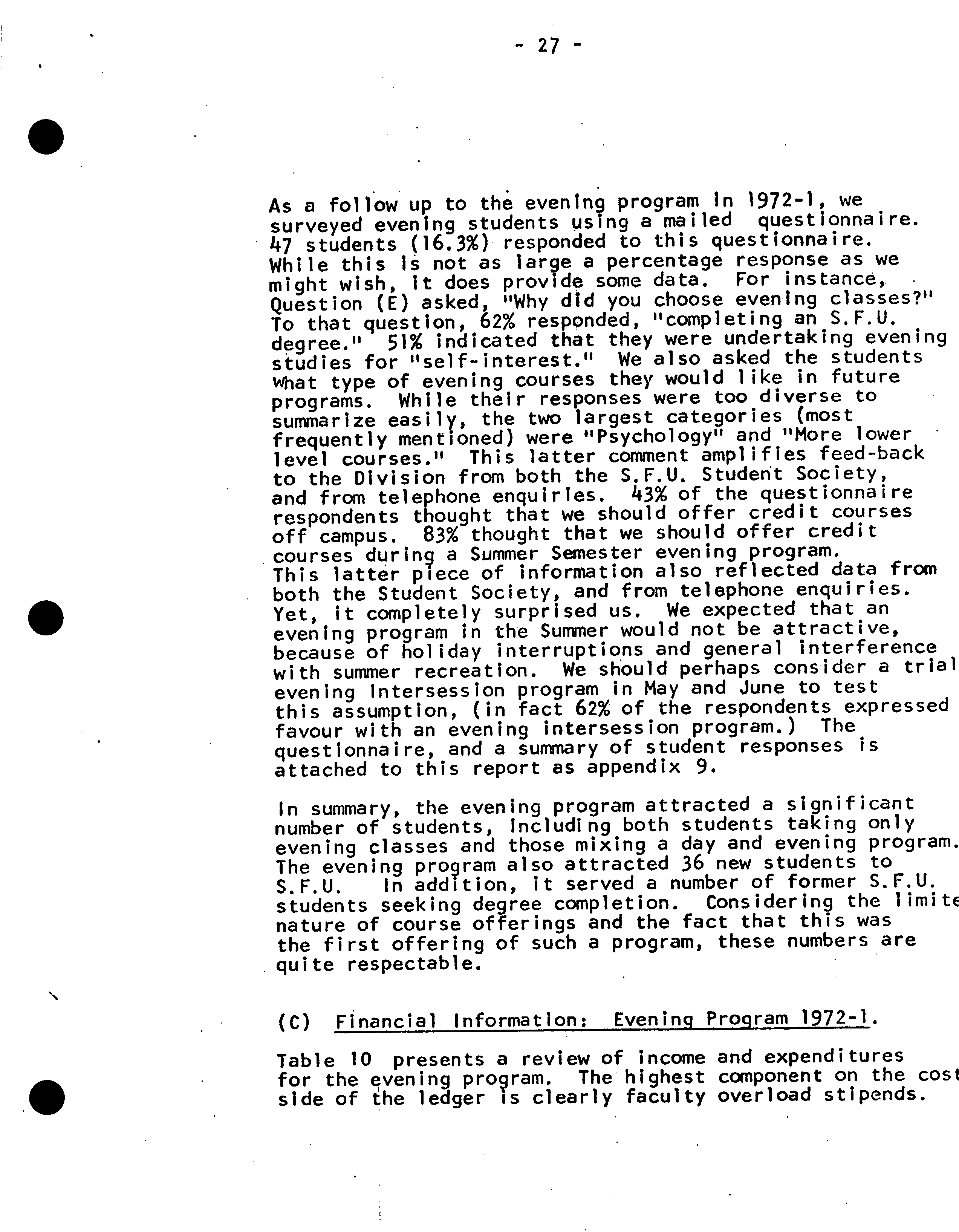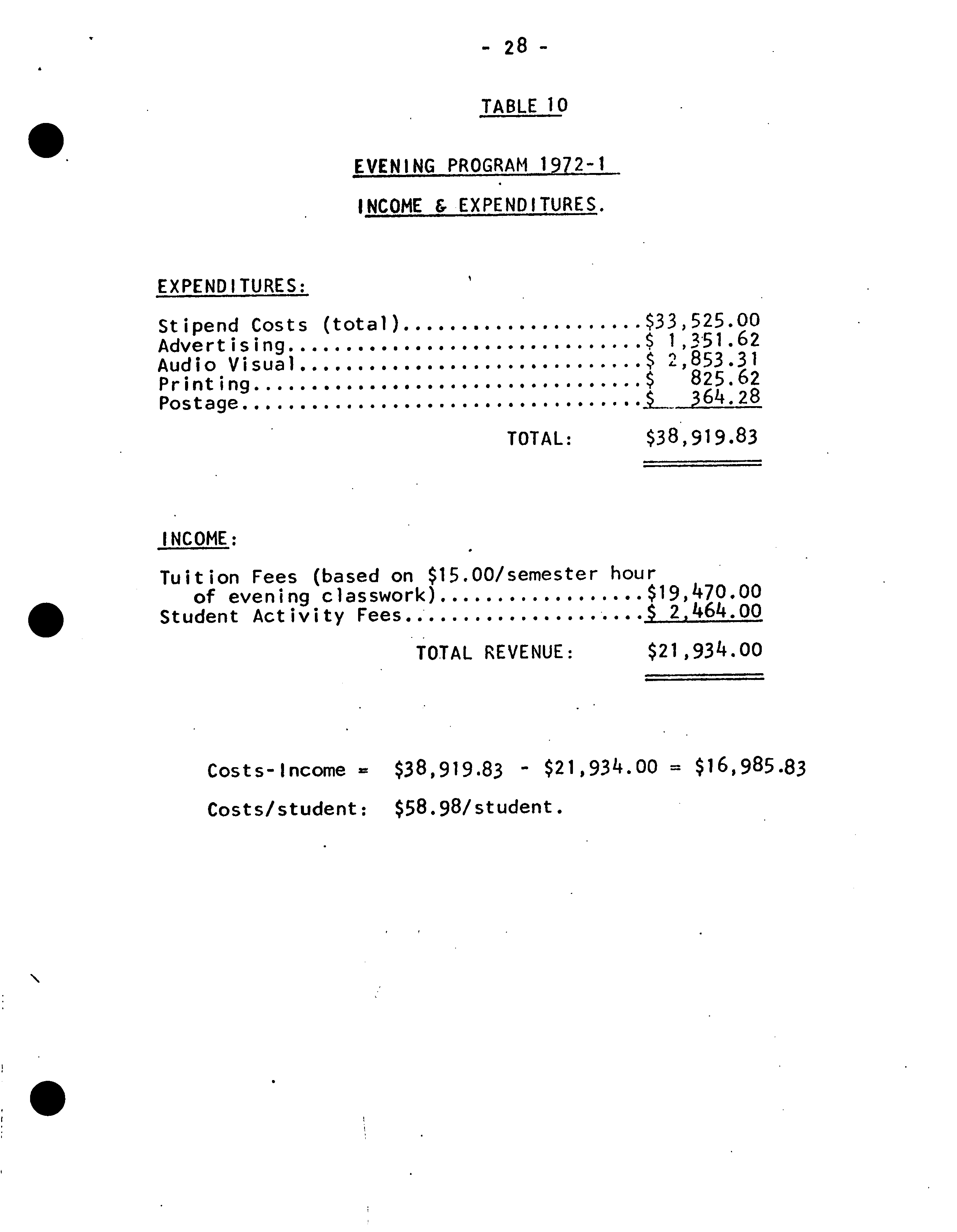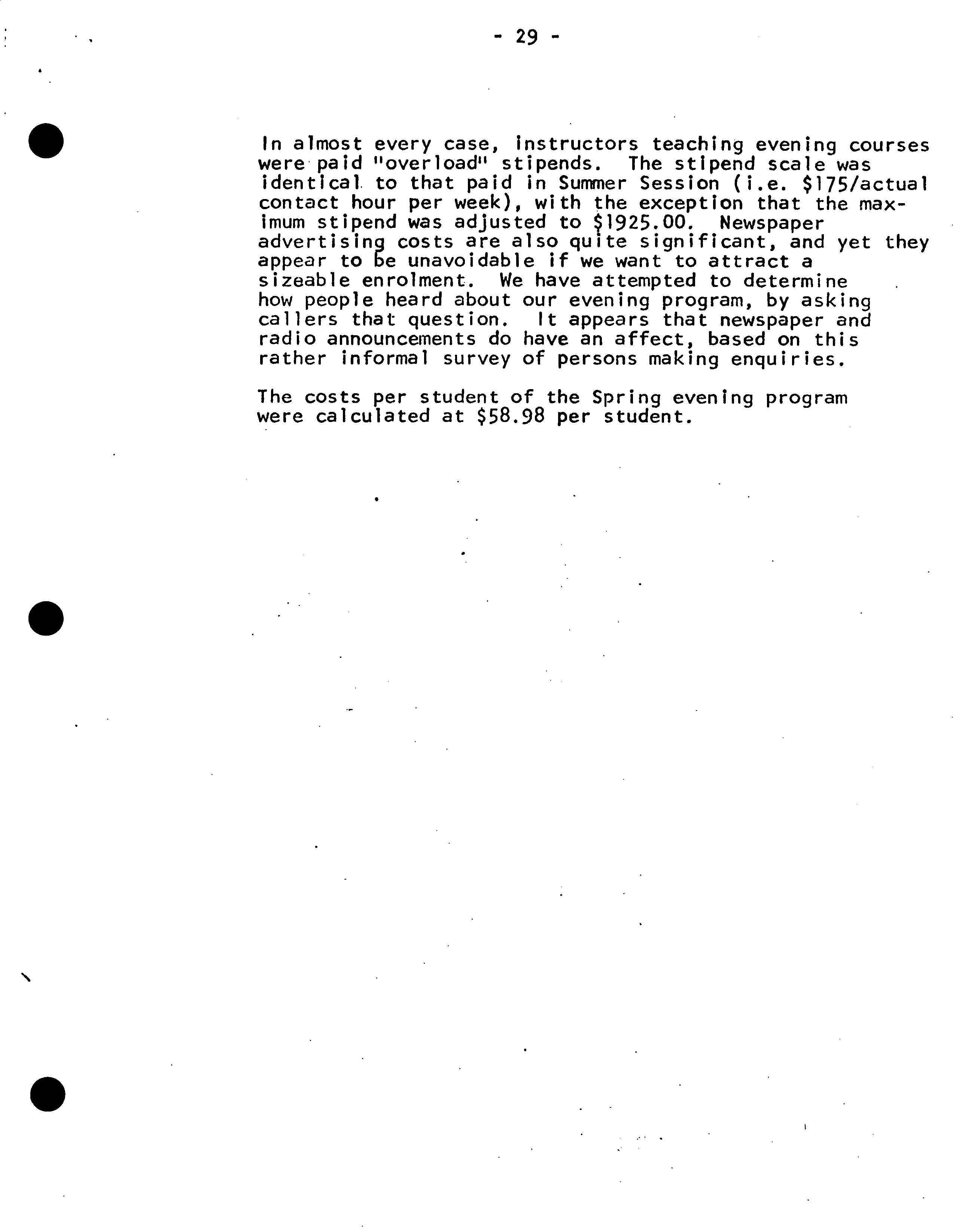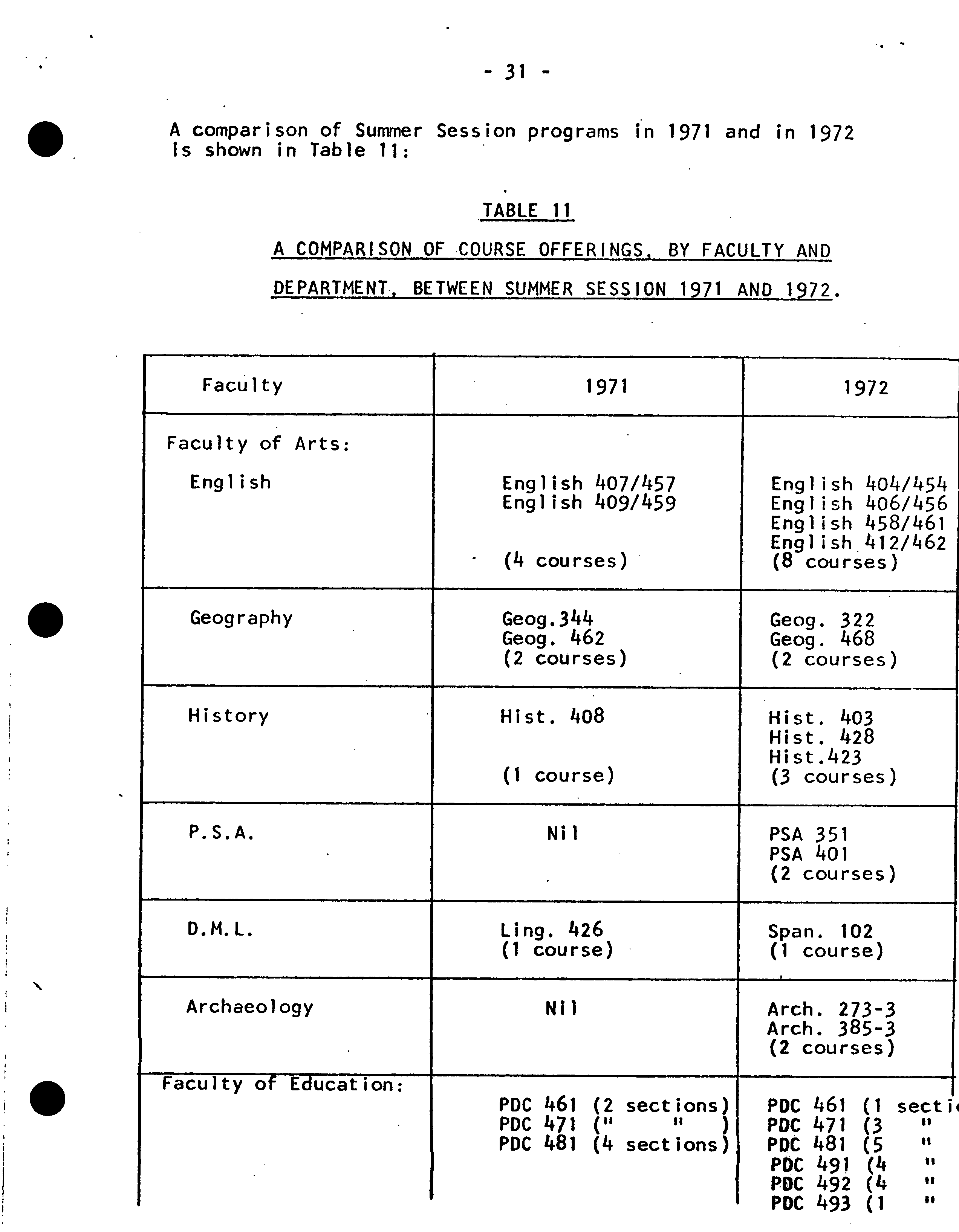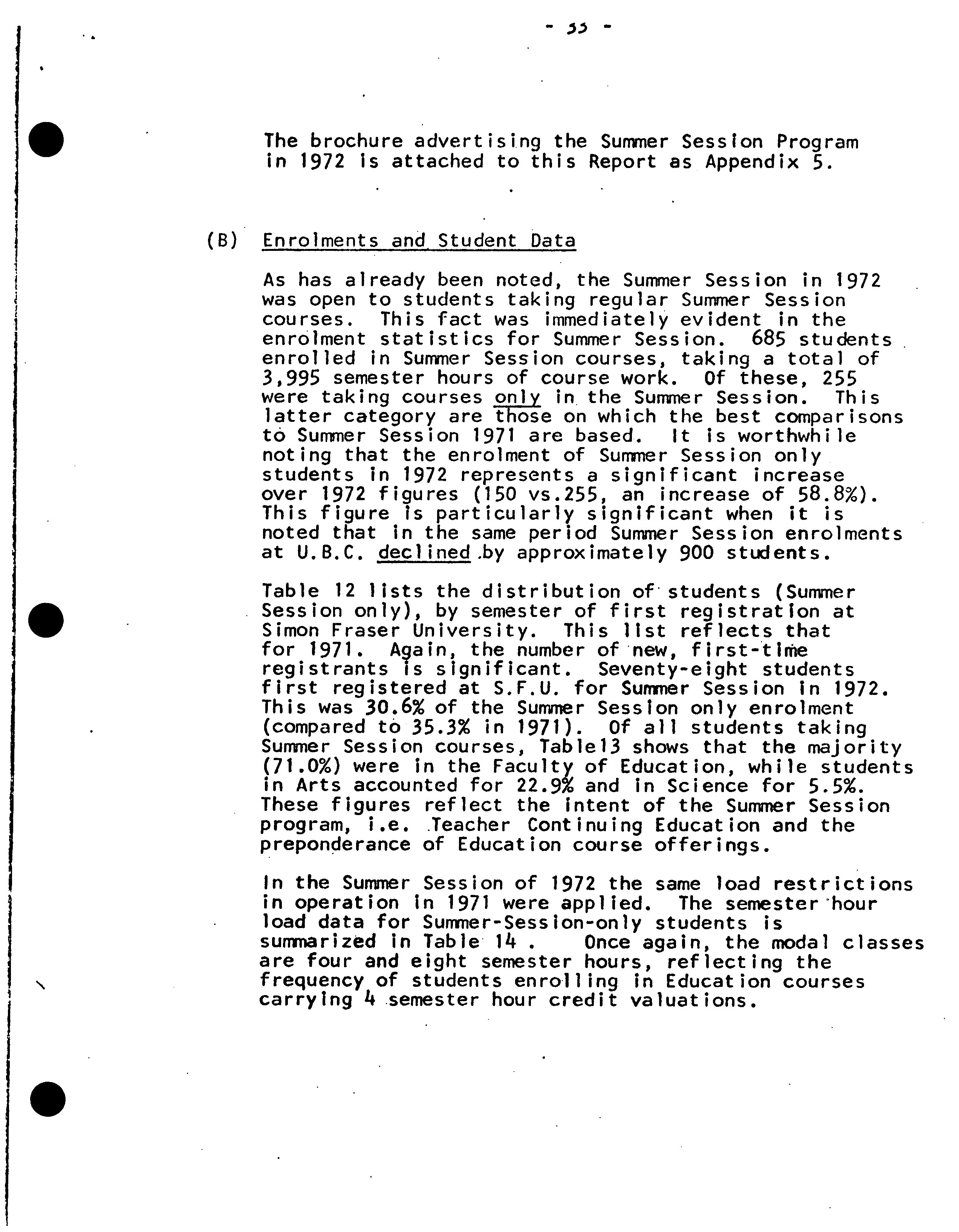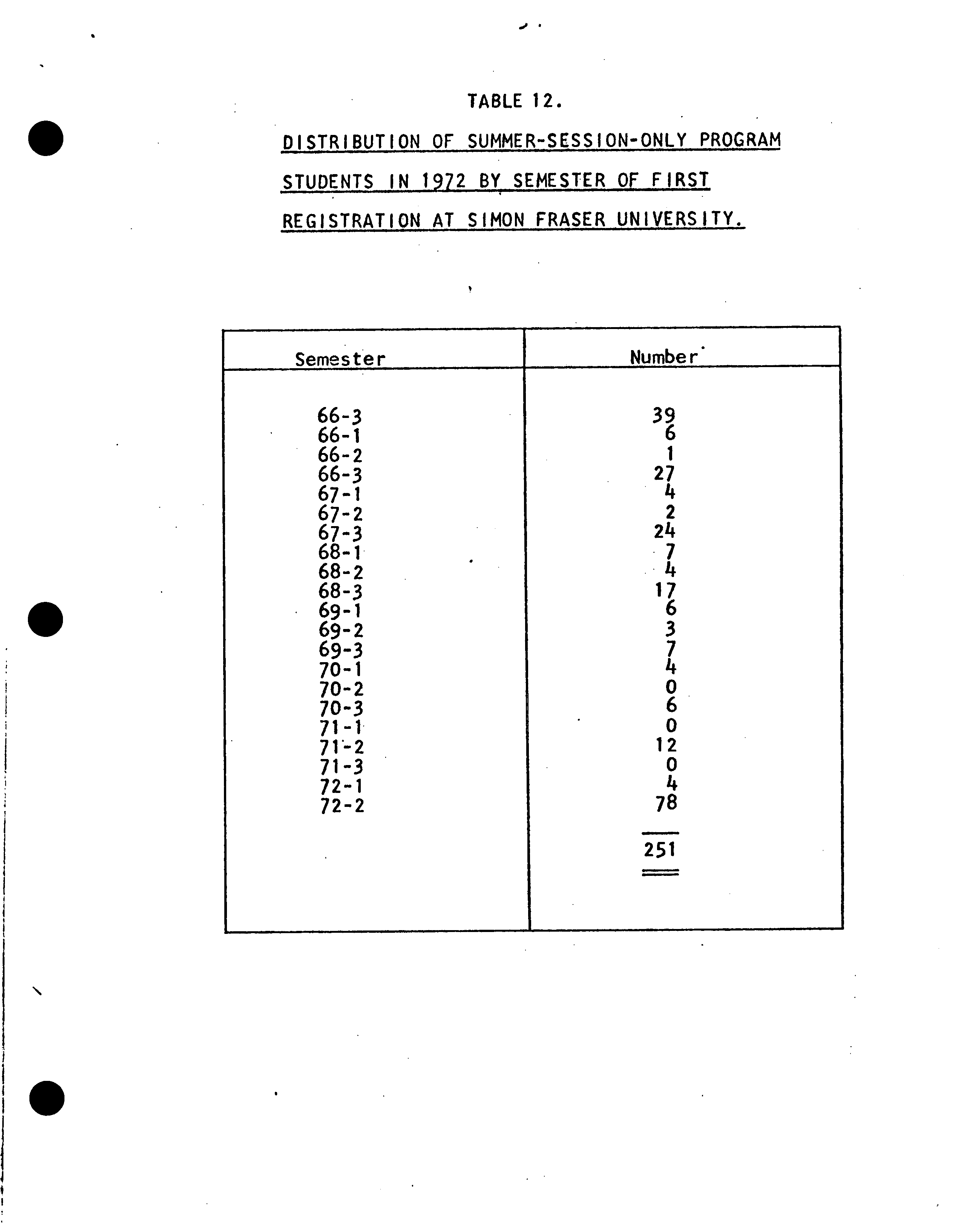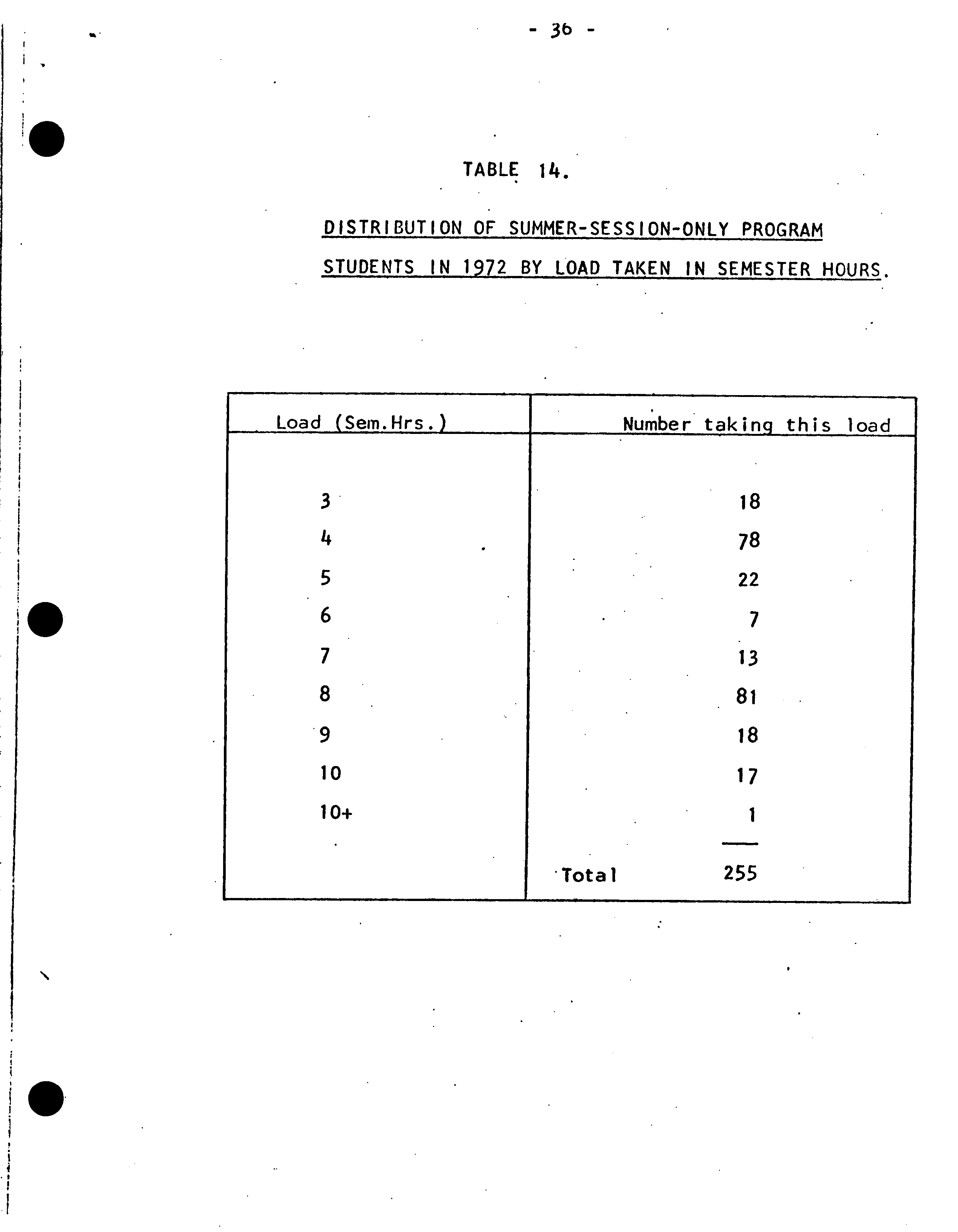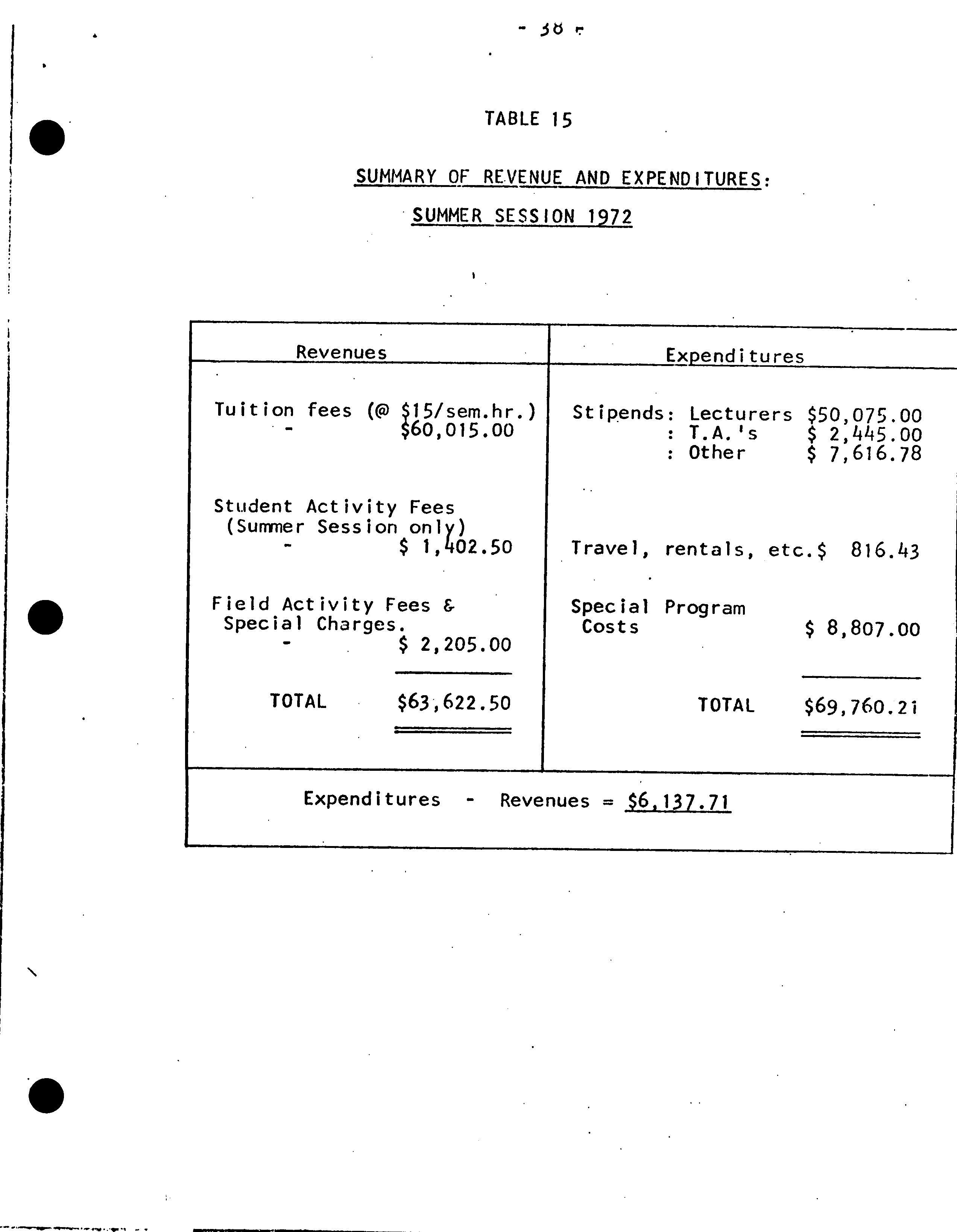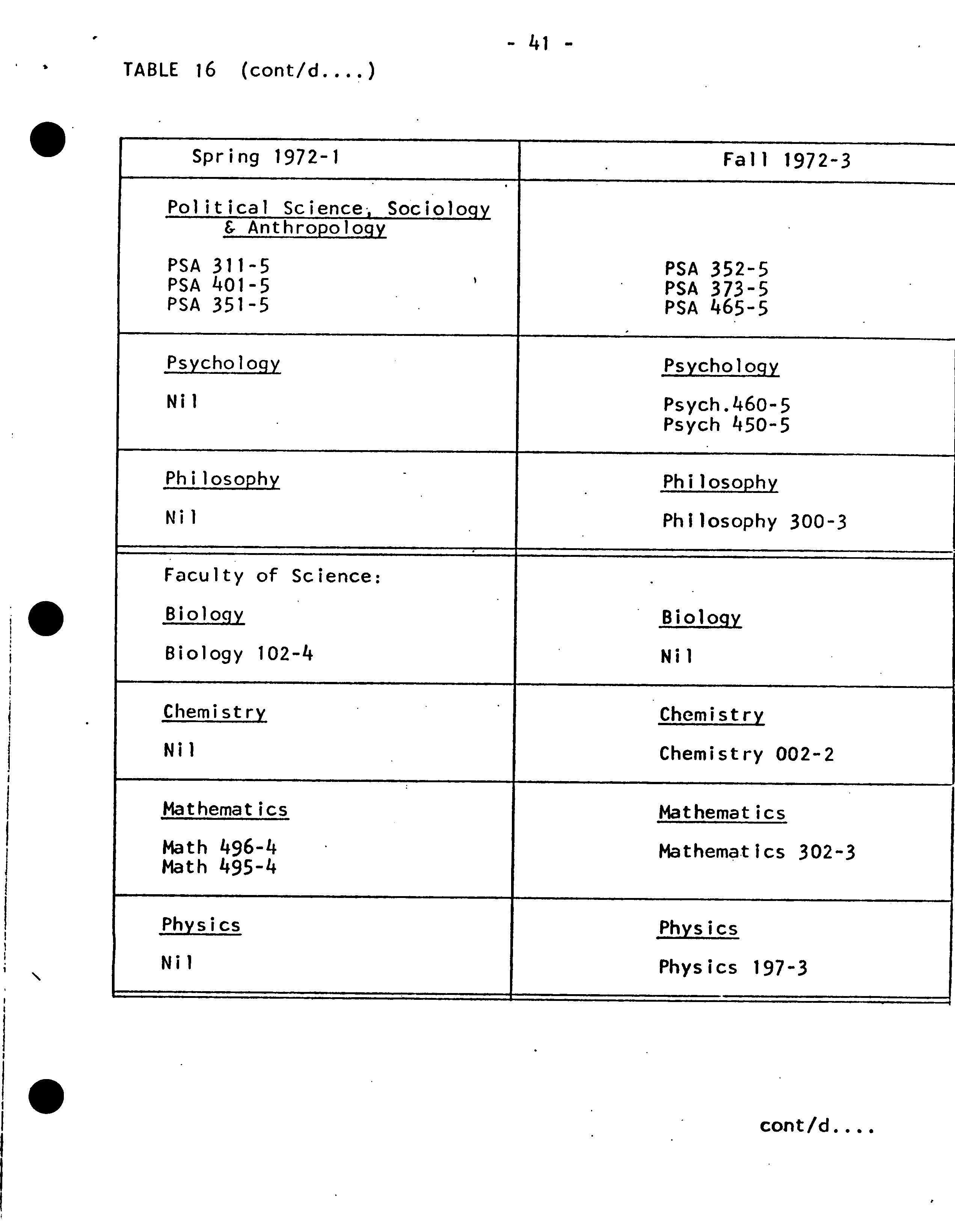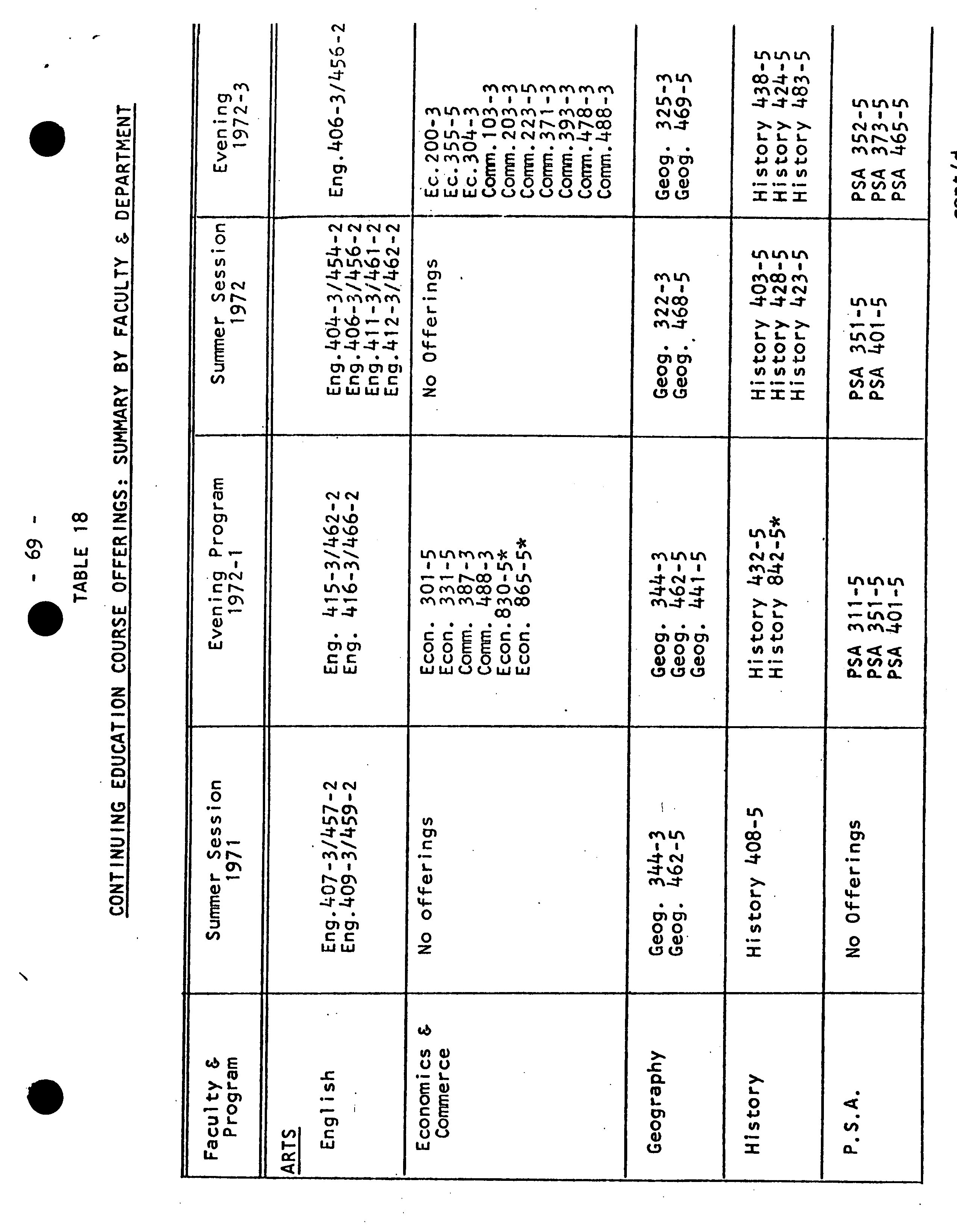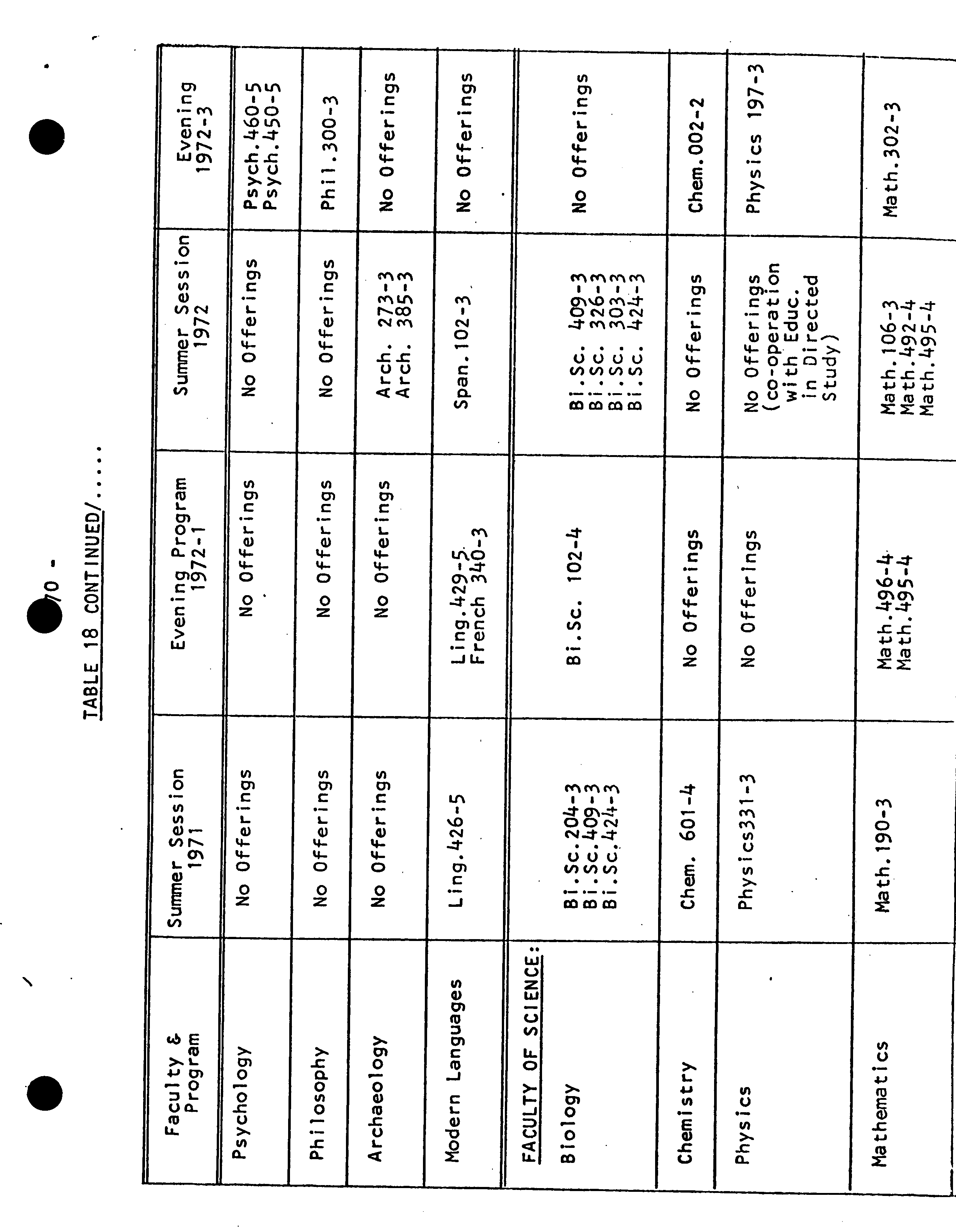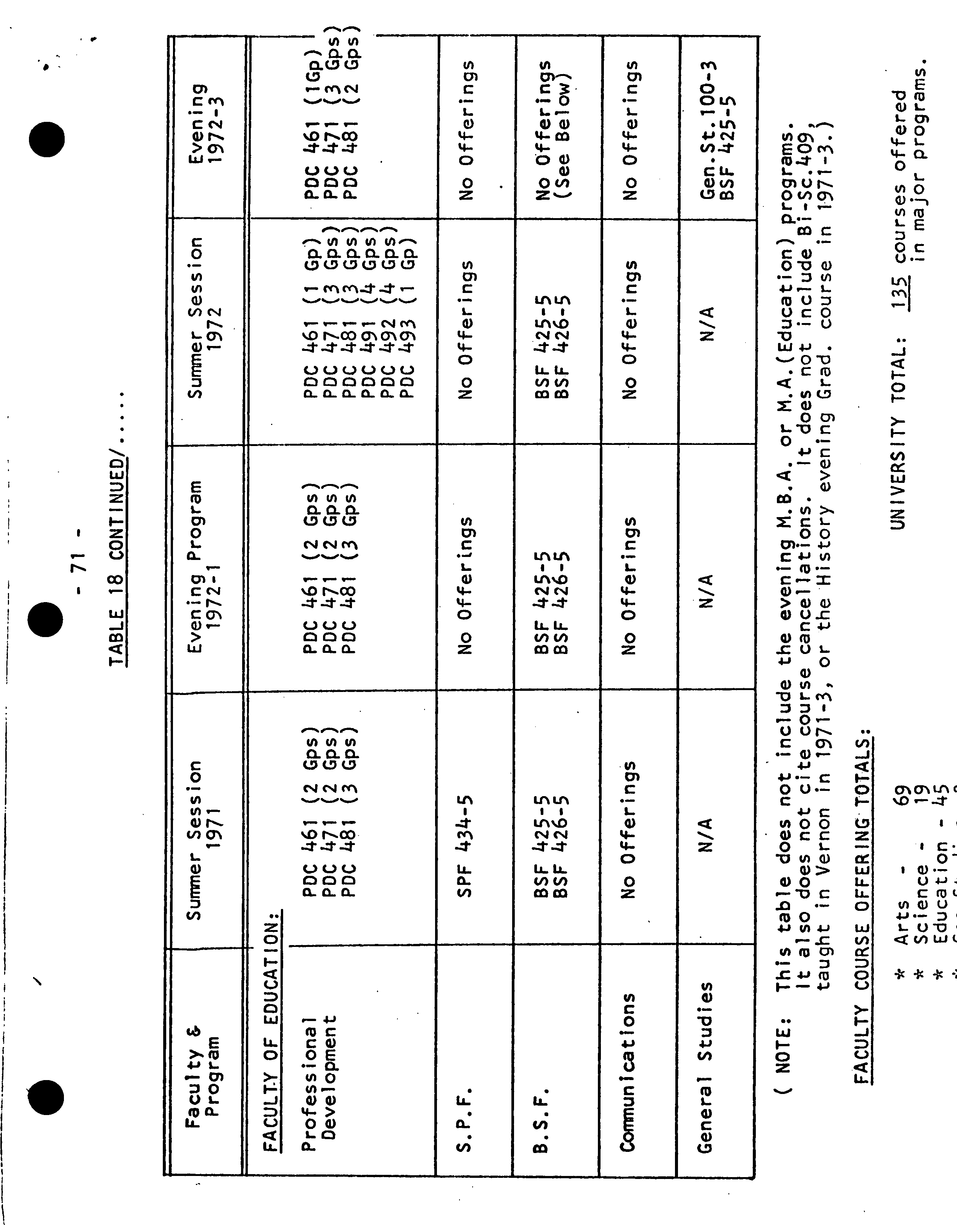SIMON FRASER UNIVERSITY
72,'2
MIMORArnM
To
From
REPORT-DIVISION .
OFCONTP!P
.
'
.G
EDUCATION
VICE-PRESIDENT,
Date.......
OcTOB
E R
i 1972
.
0
-1-
.
I.
INTRODUCTION AND TERMS OF REFERENCE
It is the purpose of this report to present a
factual summary of. the operation of the
Division of Continuing Education at Simon Fraser
University, from the time of establishment of
•
the Division in
1971,
through until June, 1972.
The report presents factual and numerical data
wherever possible. Where data is lacking, or
Is unobtainable, this is noted. The report
should enable an objective review of the Division's
activities by the Academic Planning Committee.
It should, hopefully, provide data on which to base
development of new University policies, or revision
of existing policies.
S
-2-
II. REVIEW OF PROGRAMS
OFFERED BY THE DIVISION
The Division of Continuing Education at Simon Fraser
University has attempted to operate within the context
of certain defined criteria. These have been:
(1)
The Division will concentrate on the
offering of "credit" programs,
particularly at the upper division
undergraduate level, to increase
opportunities for degree completion for
adult students.
(2)
The Division will attempt to complement
educational opportunities now available
through other InstitutIons.
• (3)
The Division will attempt to procure
information on needed areas of program
development, and will conduct surveys
and pilot projects to assess these.
(14)
The Division will attempt to make the
educational resources of the University
more available to the total provincial
community.
To-date, the Division has offered the
following
programs:
1.. July-August,
1971.
Summer Session.
(Brochure: appendix 1 , Course
list and
faculty: appendix 2 .)
2. Fall Semester, 1971.
During this semester the Division offered
no large programs, preparing Instead for
evening course offerings in Spring 1972.
This lag-time was specifically requested
by a majority of University departments.
-3-
.
11.
2.
continued!...
The Division did sponsor an evening
M.A. program in conjunction with the
History Department, and also offered
a Reading & Study program aimed at the
business and professional community.
(See Section VIII)
In addition, one
credit course was offered in Vernon, B.C.
3.
Spring Semester, 1972.
Evening Program.
(See Brochure, appendix
3)
(
See Course
and Faculty list: Appendix 4
In addition the Division offered one
credit course In Vernon, B.C. and repeated
the Reding & Study Program. (Section VIII)
4. Summer,
1972.
The Summer Session.
The Summer Session for
1972
has now been
enrolled and applications are closed.
(See Brochure : appendix 5
. See Course
and Faculty List, appendix 6 )
5.
Fall Semester,
1972.
Evening Program.
The Division has developed and advertised
Its evening program for Fall, 1972.
(See Brochure, appendix
7
and Course
and Faculty List, appendix 8 ). No
enrolment statistics are
yet
available,
but cost projections are Included in this
report. In addition, the Division is
offering a credit course in Vernon, B.C.
Other programs and activities of the Division are
reviewed In Section VIII of this report.
Each of these major credit programs will now be
discussed In turn.
is
S
M. SUMMER SESSION. 1971.
(A) General Comments:
The Summer Session of
1971
was given first
priority by the Division, because of the
pressing need to service the requirements of former
graduates of the Professional Development
Program at Simon Fraser University. Since
the inception of that program, a large
number (in excess of 1,000) students had
graduated lacking completed Bachelor's degrees.
These students had been unable to. return to
Simon Fraser University because the Summer
Semester did not articulate with the school
"year". The Summer session program in 1971
was
developed primarily with the needs of
this group in mind. Because Faculty of
Education data indicated that the majority
of these students were seeking to complete the
B.A. degree, or at least a B.Ed. with an
academic emphasis In the Arts, the majority
of course offerings were In the Faculties of
Arts and Education, although several Science
courses were also offered. Table I. is a
list of courses offered, by Department and
Faculty.
1^1
-5-
TABLE
I.
.
SUMMER SESSION COURSE,
1
971:
SUMMARY BY
DEPARTMENT
& FACULTY.
Faculty of Education
Professional Development
Centre:
7
courses*
Educational
Foundations
Centre:
Behavioural
Sciences. Foundation:
2 courses
Social
& Philosophical
Fnds:
1
course**
Faculty Total:
10
courses.
Kinesiology:
1
course**
Faculty of Arts:
English:
4
courses
Geography:
2
courses
History:
I
course
Modern Languages:
1
course
Faculty Total;
8
courses.
•
Faculty of Science:
Biology:
3
courses
Chemistry:
1
course**
Physics:
1
course*
Mathematics:
1
course**
Faculty Total:
6 courses
University Total:
25
courses
Departments not offering
courses in
Sumer
Session
1971:
P.S.A.
Psychology
Economics & Commerce
Philosophy
Communication Studies.
**: Course subsequently cancelled because of low enrolment.
IWE
As can be seen from Table 1, the number of courses
offered was not large, especially when compared
to the number of courses in the total University
calendar. In the Summer of 1971, however,
departments had only
45
days in which to identify
course offerings, in order that appropriate
advertising material could be sent to schools and
to former students with sufficient lead time to
allow application. All of the courses were upper
division, with the exception of Mathematics 190:
Mathematics for Teachers, which was subsequently
cancelled.
5
(B) Students in Summer Session 1971
The Summer Session program in 1971 attracted 150
students, who generated 317 course enrolments.
Table 2 shows the distribution of these students
Into courses.
S
0
TABLE 2.
2.
SUMMER SESSION COURSE ENROLMENTS: SUMMER SESSION 1971-
Faculty of Education:
PDC
1
+61 (Section A) ................. 30
PDC
1
+7)
(Section A) .................
20
PDCk61(Section
B)*
............
25
PDC
1+71
Mction
ction B)*
25
PDC
1 t81
A)
...............
53
PDC
L
I81 (Section
B) .....
18
PDC
I
181 (Section C)
.............8
Total PDC:
179
B SF
1+25
..............................13
B SF
1+26 . . . .......
. ........
9
Total Faculty of Education .. ........201
Faculty of Arts:
English 1+07
...... . . . . . . . . .. . . . . . . .
13
English 1157 .........................
12
•
English
1
+09 ..................
20
English 1+59 .................
...
20
Geography
31+4 . .....................
7
Geography
462
...................
6
History 1+08 . . . . . . ... . . . . . . . . . ....... 9
Linguistics
426
...............
7
Total Faculty of Arts ...............
89
Facult y
of Science:
B i.Sc.
1
12 1.
1
.
. .
. .
........
......•
.
. •...
17
B i.Sc.
1109 . . . . . . . . . . . . . . . . . . . . . . . . . .
5
Total Faculty of Science ............
22
Total Course Enrolments:
............317
*
Offered In Kamloops, B. C.
0
off AE
Certain additional information is available about
this group of students. Specifically, their
distribution by Faculty was:
Education
-
110
Arts
-
30
Science
-
10
In terms of academic goal, 57 listed the'B.Ed.,
7 listed the B.Sc., and
69
listed the B.A. as
their goal. The remainder had no declared
academic goal. The sex distribution showed a
predominance of women, with 107 females vs.
133
men.
From the standpoint of the group which Summer Session
was intended to serve, Graph I Is most interesting.
This graph shows the distribution of Summer Session
students by semester in which they first registered
at Simon Fraser. The two largest categories are
clearly apparent: Semester
65-3
and Summer Session
71-2. There was also a large group from Semester
66-3.
Clearly, Summer session 1971 appealed to'
two student groups: students who had been among
.
the earliest to register at Simon Fraser University
(and who had likely been away for several semesters).
The second group was those totally new to Simon
Fraser University. This data suggests that
Summer Session in 1971 accomplished two objectives:
(a)
It provided a Continuing Education
opportunity for former students who
had been away from Simon Fraser
University for some time,
and,
(b)
It attracted new students to the
University.
C
2
40
l94r Z1
I
'S^
M7-1
I7-24I
U
U
I,,-I
fi
I99- 3j1
1976-149
,
I1o.2
I97ø3-l1
197H
197-2
- su -
.
It should be noted that in the Summer Session
of 1971, regular Summer Semester students were
not allowed to register for Summer Session
courses. Thus, the Summer Session student
group was totally discrete from Summer Semester
students (with one known exception, Gordon C.
betta #70300-1815).
Table
3
shows the distribution of Summer Session
students in 1971, by levels, It should be noted
that the major classes in this distribution are
those at level 7 and up. This once again indicates
that Summer Session served students at that
advanced stage of their education. This would
be expected, given the fact that Summer Session
.
was designed to serve this group, and that course
offerings were almost exclusively in the upper
divisions.
TABLE
3.
.
152*
*Two students shown in this group, subsequently
dropped, reducing the total to
150.
They were
Included in these statistics, however.
'S
DISTRIBUTION OF
1971
SUMMER SESSION STUDENTS
BY LEVEL.
Level
Number Registered
1
17
2
3
3
.
3
i f
.
.
3
5
2
6
1
7
39
8
.
39
9/9+
42
- 12 -
.
11
In establishing Summer Session in 1971,
we paid
cognizance to the intent expressed in Senate
minutes, that students not take more than 9
semester hours of work in Summer Session. We
adjusted this figure to 10 semester hours, in
order to allow combinations of two
5
semester
hour courses required of some students.
Students were permitted to exceed 10 hours only
with special permission, either from the
Dean of the Faculty, or myself as Director of
.
Continuing Education. The distribution of
students, in terms of load taken, is shown in
Table 4
- 13 -
.
TABLE
1•
DISTRIBUTION OF LOAD UNDERTAKEN BY SUMMER SESSION
STUDENTS IN 1971, BY SEMESTER HOURS.
.
# of hours
taken
(Total)
Number in Category.
3
13
k
31
5
12
6
2
7
2
8
55
9
18
10
12
10+
5
N
= .
150
=
.
6.87 hrs.
\
.
.
- 14 -
S
It should be noted that the modal class in this
distribution is 8 semester hours. This should
be expected, as combinations of two education
courses (4+
1
+) would give this value. This is
also repeated in the size of the + semester hour
class, which is the second largest category in
the distribution.
In short, combinations of
1 or 2 4-semester hour courses were most popular
(C) Financial Considerations: Summer Session 1971.
Table
5
shows the tuition fee revenues produced
by Summer Session in 1971, as well as the revenues
produced by student activity fees, and field
work fees. Fees were assessed to Summer Session
students on the basis of the normal S.F.U.
tuition fee schedule, or $15/semester hour for
students taking less than 12 hours. Student
activity fees were modified with Board approval
from $11/semester to $5.50 for Summer Session
5
students, reflecting their shorter time in
attendance..
The stipends paid to faculty appolntedto Summer
Session were based on a non-rank-weighted scale
of $175/actual contact hour per week, to a
maximum of $2,450 In cases of instructors
teaching more than 10 hours per week. (An
Instructor teaching a 5-semester hour Summer
Session course would normally have 10 contact
hours per week during Summer Session.) Stipends
were based on recommendations
made by
Departmental
Chairmen., andwere approvedby the Director of
Continuing Education, Academic Vice-President,
and Board of Governors.
0
- 15 -
TABLE
5
FINANCIAL STATEMENT, SUMMER SESSION
1971
.
COURSE
ENROLMENT
FEE
REVENUE*
STIPEND
PAID
English
1
+07
13
$9L15
$21450
English 1457
12
English
409
20
ggsl5oo
$21450
English
1459
20
Geography 344
7
$315
$1050
Geography
1462
,
6
$450
NONE
History
408
9
$675
$1750
Linguistics
1426
7
$525
$1750
Bi.Sc.
1424
17
$765
$1600**
Bl.Sc. 1409
5
$226'
$1750
BSF
1425
13
$975
$1750
BSF 426
9
$675
$1750
PDC 1461
POC 471
25
25
WOO)$300(
$2800**
PDC 461
30
$1800
$11400
PDC 471
20
$1200
$11400
PDC 1481
53
$3180
$11400
POC 481
18
$1080
$11400
PDC 481
8
$480
$1400
TOTALS
317
$17,790.00
$26,100.04
v'oseu on
twrteacfl,ng
$15/semester team totals)
hour)
CO NT / 0. . . . . .'.
0
TABLE,
5
contlnued/.....
.
Student
Advertising:
Activity
Fees:
$616.00
Brochjre:
$2510.16
Newspaper:
$
716.26
Postage:
$ 33.00
$3560.42
Field
Activity
Fees:
$1310.00
Miscellaneous:
$800.00
Total
Revenue:
$19,716.00
Total
Expenses:
$90,460.42
Net Costs:
$10,74
1
+.32
Cost!
Student
=
$7163***
***: Not including office expenses and administrative
expenses In the Division of Continuing Education.
(i.e.-Permanent staff and overhead)
C
- 17-
.
It should be noted that Table5 does not take consid-
eration of revenue possibly gained by the University
on the basis of full-time equivalent revenues.
It deals
only with actual fees paid vs. costs. Costs are based
only on costs directly and solely associated with.
Summer Session, but do not include portions of the
"normal" operating expenses of tt Division of Contin-
uing Education. On this basis, Summer Session costs
were
$10,744.32
or $71.63/student enrolled.
Summer Session costs in 1971, that is $30,460.
1
42 were
assessed against the budget of the Division of Contin-
uing Education. On the other hand, the revenues gained
($19,716.00) were sent into University General Revenues.
The budget modifications In operation during 1972
should provide a better indication of both revenues
and costs, in as much as revenues will accrue to the
Division's program budget.
(D) Summary
is
The Summer Session of
1971
attracted 150 students
to the University. It can be assumed that many of
them would not otherwise have been able to attend.
The Session provided services mainly to students
completing upper division work. Major student
categories were found both in new students, and in
S.F.U. students whose first registration was 1965 or 1966.
The Session cost the University $71.63/student enrolled.
- 18 -
IV. FALL SEMESTER, 1971
In the Fall semester of 1971, the Division of
Continuing Education did not operate an evening
program on campus. It did adminstrate the offering
of a credit course (Biological Sciences 409-3)
In Vernon, and the operation of an evening course
In History, in conjunction with the development of
an evening M.A. program in History. These courses
are discussed In more detail elsewhere in this report
(SectionVlll ). In accordance with our policy of
giving first priority to the development of credit
programs, the Division did not attempt to develop
a non-credit program similar to those at U.B.C. or
University of Victoria. The Division did advertise
and provide some administrative support for the
Reading & Study Centre's program "Reading For Business
& The Professions" in the Fall of 197). Details
of this program are also provided in Section Vi I I
of this report.
S
\
0
- 1 -
.
V. EVENING PROGRAM, SPRING 1972
(A) General Comments
In Semester 1972-1, the Division of' Continuing
Education offered a program of evening courses,
on the S.F.U. campus. Courses were offered in
the Faculties of Arts, Science and Education.
The brochure advertising this program was
distributed in Semester 1971-3 (See appendix
3 ).
By the Fall of 1971, the Division had established
a mailing list of more than 3000 addresses, linked
to a computerized labelling system. The Division
was assisted in this by the Methods Study Depart-
ment of the Ancillary Services Unit, and by the
Computing Centre. The establishment of a
comprehensive mailing list and of a suitable mailing
system was a major problem facing the Division
during the Summer Session of 1971. Basically, the
campus possessed a bewildering variety of mailing
lists, of various degrees of sophistication, and
in various states of revision in terms of how
up-dated the addresses were. The systems included
separate lists in the Faculty of Education, Arts,
Centre, Economics and Commerce Department,
Registrar's Office, and Alumni Association. Systems
ranged from hand-labelling, to addressograph,
(manual and machine) to computerized label print-out.
While we tried to avoid developing yet another list,
and attempted to use one or several of the existing
lists, this proved to be impossible. Accordingly,
we have devised a computerized system which is:
S
(a) Up-to-date
(b') Flexible
(c) Fast
(it includes 9
i.e.
schools,
in enquiries,
major categories,
business, phone-
general, etc.)
- 20 -
While we can generate a set of address labels with ease,
we still have no really good on-campus envelope stuffing
ard labelling facility. This omission is costly, because
It necessitates hiring from one to three part-time
employees for each major mailing, and also slows down
the mailing process.
I discuss the mailing problem here
because it is Illustrative of the type of simple,
mechanical and logistic problem which must be solved in
establishing a new Division of Continuing Education.
A list of course offerings and faculty for the evening
program during semester 1972-1 is attached as appendix
14
Thirty-one courses were offered on campus, while two
courses were offered off-campus in Vancouver, and a
further course was offered in Vernon. Of the thirty-
one on-campus courses, three were graduate courses.
These statistics do not include evening graduate
courses in the M.B.A. program or in Educational
Adminstrat Ion.
(B) Enrolment and the Student Population.
The evening program attracted 288 students. Of these,
120
students registered only for evening classes
(41.5%).
The program was open both to "daytime" SFU students
as well as to students registering strictly for evening
courses. Table
6
and Graph 2 show the distribution of
students registering for evening classes, by year and
semester of first registration at S.F.U. Note that this
distribution is entirely different from that for Summer
1971. It contains a series of "peaks" corresponding to
Fall semesters of each year since
1965.
This distribution
is likely more representative of the fact that most
students first register in the Fall semester of any
V
year. The exception to this is semester 72-1,
in which 48 evening students also first registered at
S.F.U. Of these 48 students,
36
were registered only
for evening courses (75%). These
36
students represented
12.5%
of the total evening enrolment. This Is a measure
of the ability of the evening program to attract students
who have had absolutely no previous contact with S.F.U.
as registered students.
.
0
- 21 -
S
TABLE 6
DISTRIBUTION OF EVENING STUDENTS BY YEAR
AND SEMESTER
OF FIRST REGISTRATION AT S.F.U.
.
S
Year & Semester
.
Number
in Category
1965-3
27
66-1
11
66-2
1
• 66-3
30
67-1
6
67-2
1
67-3
24
68-1
5
68-2
0
68-3
33
6
9-1
12
69-2
5
69-3
•.
29
70-1
.
8
70-2
.
4
70-3
24
71-1
.
7
71-2
.
.
5
71-3
.
16
72-1
48
-22-
&
to
(D
0 -'
0
0
0
0
0 <
1965-3
66-1
66-2
66-3
67-1
67-2
67-3
68-1
68-2
68-3
V)
69-1
rn
69-2
69-3
z
0-<
D
70-2
70-3
o
1-1
-I
'
71-2
1/)
—4
'
P1
'
2-1
C)
In
—I
—4
0
- 23 -
11
.
Table
7
shows the breakdown of
evening students
by faculty:
TABLE
7.
DISTRIBUTION OF EVENING STUDENTS BY FACULTY.
Faculty of Arts
167
Faculty of Education
72
Faculty of Science
18
Faculty of General
Studies
3
Kinesiology
Unspecified
27
TOTAL:
288
I•
L
- 2 -
S
TABLE 8
LOAD DISTRIBUTION IN TERMS OF SEMESTER HOURS
OF EVENING
CLASSES: EVENING PROGRAM 72-1
.
NO. of hrs. of
evening classes
No. of students
undertaking
load.
3
and less
53
4
55
5
149
6
S
1
7
5
.0
8
9
9
'3
lO and over
5
6
Auditors
S
N
. 288
0
- 25 -
Table 7 demonstrates our need to develop appropriate
evening programs in Science and General Studies.
To-date, we have notsufficiently publicized our
General Studies program as having significant
advantages to part-time students (because of its
inherent flexibility). We must do more toerrphasise
this fact. Twenty-three evening students were
registered with the status of "special student." At
present our regulations prohibit students in this
category from applying their work toward a degree, and
they also prohibit a student with one undergraduate
degree from attempting a second. These clauses will
need a thorough review, if we find that a significant
number of evening students fall into "special student"
categories.
The load undertaken by evening students in terms of the
number of semester hours undertaken in evening classes,
is shown in Table 8 •
This table shows that the
majority of evening students
(51.7%)
took a total of
5
semester hours in the.evening. Lesser, but significant
numbers undertook either a total of
3
semester hours
(18.4%) or k
semester hours (19.1%). Only 20 students
•
took more than
5
semester hours. Although the
University has no statutory limits on the load which
may be undertaken by evening students, our literature
advised students not to undertake more than
5
semester
hours of evening work. The distribution of data in
Table
8
suggests that most students are taking
appropriate loads in the evening.
Data obtained from evening student address lists shows
(Table 9 ) clearly the areas In the greater Vancouver
region from which most students come. The largest number,
(20.1%) came from North Burnaby, the area immediately
surrounding S.F.U. The next largest group came from0
South Burnaby., and the Municipality of Burnaby contributed
a
total of 102 evening students
(35.4%).
The City of
Vancouver proper, contributed another
54
students
(18.8%). Significantly, Coquit.lam, a Municipality
Immediately bordering S.F.U. contributed only 27 students
(9.4%). This may be due to poorer road connections between
Coquitlam and the campus. The connection of the Como Lake
Road extension with the campus ring road might change this
statistic.
0
-
26 -
4
TABLE 9
DISTRIBUTION OF EVENING STUDENTS BY ADDRESS OF RESIDENCE
Area (Postal Zone
Burnaby 1
Burnaby 2
Burnaby
3
Vancouver (unspecified)
Vancouver 3
Vancouver
5
Vancouver 6
Vancouver 8
Vancouver 9
Vancouver 10
Vancouver 12
Vancouver 15
New Westminster
Delta
Surrey/Whal ley
Langley
Haney/Maple Ridge
Coquit lam
Port Moody
North Vancouver
West Vancouver
Richmond
Mission
Number of student
35
58
.9
22
1
k
3
2
6
4
9
5
•
13
•
8
21
4
5
27
8
16
10
2
1
C
- 27 -
.
As a follow up to the evening program in 1972-1, we
surveyed evening students using a mailed questionnaire.
17
students (16.3%) responded to this questionnaire.
While this Is not as large a percentage response as we
might wish, It does provide some data. For instance,
Question (E) asked, "Why did you choose evening classes?"
To that question, 62% resppnded, "completing an S.F.U.
degree."
51%
indicated that they were undertaking evening
studies for "self-interest." We also asked the students
what type of evening courses they would like in future
programs. While their responses were too diverse to
summarize easily, the two largest categories (most
frequently mentioned) were "Psychology" and "More lower
level courses." This latter comment amplifies feed-back
to the Division from both the S.F.U. Student Society,
and from telephone enquiries. 43% of the questionnaire
respondents thought that we should offer credit courses
off campus. 83% thought that we should offer credit
courses during a Summer Semester evening program.
This latter piece of information also reflected data from
•
both the Student Society, and from telephone enquiries.
Yet, it completely surprised us. We expected that an
evening program in the Summer would not be attractive,
because of holiday Interruptions and general Interference
with summer recreation. We should perhaps consider a trial
evening Intersession program in May and June to test
this assumption, (in fact 62% of the respondents expressed
favour with an evening intersession program.) The
questionnaire, and a summary of student responses is
attached to this report as appendix 9.
In summary, the evening program attracted a significant
number of students, Including both students taking only
evening classes and those mixing a day and evening program.
The evening program also attracted 36 new students to
S.F.U.
In addition, it served a number of former S.F.U.
students seeking degree completion. Considering the limit(
nature of course offerings and the fact that this was
the first offering of such a program, these numbers are
quite respectable.
•
(C) Financial Information: Evening Program 1972-1.
Table 10 presents a review of income and expenditures
•
•
for the evening program. The highest component on the cosi
side of the ledger is clearly faculty overload stipends.
-28-
TABLE 10
EVENING PROGRAM 1972-1
INCOME & EXPENDITURES.
EXPENDITURES:
Stipend Costs (total). . . . . . .. . . ..........
$33,
525.00
Advertising ......• • ••.••... • ..............$ 1,351.62
Audio Visual
................
$
2,853.31
Printing ......•.. . ..••.•• . . . . . . .
......... $
825.62
Postage.. .............. ........ . . . . . ........_
364.28
TOTAL:
$38,919.83
INCOME:
Tuition Fees (based on $15.00/semester hour
of evening classwork) ............ . . . . . . $19,470.00
Student Activity Fees ........................$2.,k6L.O0
TOTAL REVENUE:
$21,934.00
Costs-Income
$38,919.83 -
$21,934.00
= $16985.83
Costs/student: $58.98/student.
\
- 29 -
In almost every case, instructors teaching evening courses
were paid "overload stipends. The stipend scale was
identical. to that paid in Summer Session (i.e. $175/actual
contact hour per week), with the exception that the max-
imum stipend was adjusted to ç1925.00. Newspaper
advertising costs are also quite significant, and yet they
appear to be unavoidable if we want to attract a
sizeable enrolment. We have attempted to determine
how people heard about our evening program, by asking
callers that question. It appears that newspaper and
radio announcements do have an affect, based on this
rather informal survey of persons making enquiries.
The costs per student of the Spring evening program
were calculated at $58.98 per student.
S
0
.
- 30 -
VI. SUMMER SESSION
1972
(A) General Comments
The Summer Session in
1972
had a number of
components which made it distinctive in character
from the Summer Session of
1971.
Principal among
these was the fact that in the Summer of
1972,
regular S.F.U. Summer Semester students in the
Faculty of Education could elect Summer Session
courses as part of their overal[ Summer program.
This was done by introducing a May-June Intersession
within the Faculty of Education, with the result
that some Education courses ran for the regular
k month (May-August) Summer Semester, while others
ran for the Intersession (May-June) and others ran
for the Summer Session (July-August).
This applied only to Faculty of Education courses.
The results of this shift were several:
(1)
New Summer Semester and Summer Session
registration patterns and processes were
necessitated, and were developed;
(2)
Summer Session courses which might not attract
sufficient enrolments from strictly off-campus
students, became viable because of some influx
of Summer Semester/Session mixed program
students.
(3)
Some Summer Session courses experienced very
heavy demand, necessitating additional sections
and Instructors' stipends.
As can be seen in Table 11 , the Summer program in
1972 represented an increase of slightly less than
100% above the
1971 Summer Session program, in terms
of numbers of course offerings. Particularly signi-
ficant in this overall increase were the increased
numbers of courses offered In English, Education,
PSA, History and Archaeology.
0
- 31 -
S
A comparison of Summer Session programs in 1971 and in 1972
Is shown in Table 11:
TABLE 11
A COMPARISON OF COURSE OFFERINGS, BY FACULTY AND
DEPARTMENT, BETWEEN SUMMER SESSION 1971 AND 1972.
.
Faculty
1971
1972
Faculty of Arts:
English
English 407/457
English 404/454
English
409/459
English 406/1+56
English
458/1+61
Eng) ish4l2/462
(4 courses)
(8 courses)
Geography
Geog.31e4
Geog.
322
Geog. 462
Geog. 468
(2 courses)
(2 courses)
History
Hist. 408
Hist.
403
Hist. 428
Hist.423
(1
course)
(3
courses)
P.S.A.
Nil
PSA
351
PSA 1+01
(2 courses)
D.M.L.
Ling.
426
Span.
102
(1 course)
(1 course)
Archaeology
Nil
Arch.
273-3
Arch.
385-3
(2 courses)
Faculty of Education:
PDC 461
(2 sections)
POC 461
(1
sect
PDC 471
("
it
)
PDC 471
(3
PDC 481
(4 sections)
POC 481
(5
PDC
491
(4
POC 492 (4
p
rkt LLQA (1
- 32 -
TABLE 11 (continued!....)
.
Faculty
1971
1972
Faculty of Science:
Biology
Bio.409
Bio.
409
Blo. 424
Rio.
424
Rio.
326
Bio.
303
(2 courses)
(4
courses)
Chemistry
Chem. 601
Nil
Physics
Physics
331
Nil
Mathematics
Math 190
Math 106
Math
492
Math
495
(1
course)
(3
courses)
Behavioural
Sciences
BSF
425
13SF
425
Foundations
BSF 426
BSF 426
(2 courses)
(2 courses)
Social & Philosophical
SPF 434
Nil
Foundations
TOTALS:
24 courses
45
courses
-
-
The brochure advertising the Summer Session Program
in 1972 is attached to this Report as Appendix
5.
(B) Enrolments and Student Data
As has already been noted, the Summer Session in 1972
was open to students taking regular Summer Session
courses. This fact was immediately evident in the
enrolment statistics for Summer Session.
685
students
enrolled in Summer Session courses, taking a total of
3,995
semester hours of course work. Of these,
255
were taking courses only in the Summer Session. This
latter category are those on which the best comparisons
to Summer Session 1971 are based. It is worthwhile
noting that the enrolment of Summer Session only
students in 1972 represents a significant increase
over 1972 figures (150
vs.255,
an increase of 58.8%).
This figure is particularly significant when it is
noted that in the same period Summer Session enrolments
at U.B.C. declined.by
approximately 900 students.
Table 12 lists the distribution of students (Summer
.
. Session only), by semester of first registration at
Simon Fraser University. This list reflects that
for 1971.
A ? ain ,
the number of new, first-time
registrants is significant. Seventy-eight students
first registered at S.F.U. for Summer Session in 1972.
This was
30.6% of the Summer Session only enrolment
(compared to
35.3%
in
1971). Of all students taking
Summer Session courses, Tablel3 shows that the majority
(71.0%) were in the Faculty of Education, while students
in Arts accounted for 22.9% and in Science for 5.5%.
These figures reflect the intent of the Summer Session
program, i.e. Teacher Continuing Education and the
preponderance of Education course offerings.
In the Summer Session of 1972 the same load restrictions
in operation In 1971 were applied. The semester hour
load data
for
Summer-Session-only students is
summarized in Table 14 .
Once again, the modal classes
are four and eight semester hours, reflecting the
frequency of students enrolling in Education courses
carrying 4 semester hour credit valuations.
-I.
TABLE
12.
0
DISTRIBUTION OF SUMMER-SESSION-ONLY
PROGRAM
STUDENTS IN 1972 BY SEMESTER OF FIRST
REGISTRATION AT SIMON FRASER UNIVERSITY.
.
Semester
Number
66-3
39
66-1
6
66-2
1
66-3
27
67-1
4
67-2
2
67-3
.
24
68-1
.
.
7
68-2
.4
68-3
17
69-1
6
69-2
3
69-3
7
70-1
4
70-2
0
70-3
6
71-1
0
71-2
12
71-3
0
72-1
4
72-2
78
251
0
-
-
TABLE 13.
DISTRIBUTION
OF SUMMER SESSION STUDENTS
IN 1972 BY FACULTY.
Arts
-
157
Science
.
-
30
Education
-
487
Not listed
-
11
.
..
- 3b -
ie
TABLE 14.
DISTRIBUTION OF SUMMER-SESSION-ONLY PROGRAM
STUDENTS IN 1972
BY LOAD
TAKEN IN SEMESTER HOURS.
.
Load
(Sem.Hrs.)
Number taking this
load
3 .
.
18
4
78
5
22
6
7
7
.
13
8
.
81
'9
.
18
10
.
17
10+
.
1
Total
255
.
- 37 -
0
(C) Summer Session Costs & Revenues
The Summer Session costs and revenues are summarized
in Table 15 In this presentation only actual tuition
fee revenues have been shown, not possible revenues
accrued by full-time equivalent grants from the
provincial Financial Advisory Board.
The revenue
figures contain certain elements of error, which are
difficult to identify precisely at this time. While
fairly small in relation to the total, these error
sources should be noted.
First, revenues have been calculated by assessing
tuition fees paid as $15.00/semester hour. This is
an accurate figure for students taking less than 12
semester hours as a total load. Students taking more
than this load pay slightly less, on a per semester
hour basis. However, the difference is quite small.
The second source of error results from the fact that
tuition fee revenues actually only apply to defray
Continuing Education program costs in cases where
Continuing Education pays.-the stipend of Faculty
teaching the course, or has other costs.. In some
•
cases (albeit quite rare), Summer Session courses
are being taught by Faculty as normal teaching loads.
In other cases, one person teaching a course is doing
so on a "regular assignment" basis, while a second or
third instructor is teaching on an "overload" basis.
The "costs" column shows only overload or special
stipends required, but the revenue column shows all
revenues to all courses. At the time of writing of
this report, a final budget statement for Summer
Session has not been received from the Bursar's Office,
hence precise figures cannot be provided on the revenue
side of Table 1. The figures shown should, however,
present a fairly accurate representation of actual
revenues. On this basis, the cost per student for
Summer Session only students was $2k.07/student. This
latter figure represents a significant reduction over
1971 and can be attributed to the fact that Summer
Session only enrolments increased in 1972, and that
Summer Semester students could enrol in Summer Session
courses.
0
•
S.
TABLE 15
SUMMARY OF REVENUE AND EXPENDITURES:
'SUMMER SESSION 1972
Revenues
I
Expenditures
Tuition fees
(@
4
0,015.00
5/sem.hr)
Stipends: Lecturers $50,075.00
T.A.'s
$ 2,445.00
Other
$ 7,616.78
Student Activity Fees
(Summer Session only)
-
$ 1,402.50
Travel, rentals, etc.$ 816.143
.
Field Activity Fees &
'
Special Program
Special
-
Charges.
'
$ 2,205.00
Costs
$ 8,807.00
TOTAL
$63,622.50
TOTAL
$69,760.21
Expenditures - Revenues =
$ 6,137.71
I \
0
- 39 -
.
(VII) EVENING PROGRAM: FALL 1972
The evening program in
1972-3
has been advertised
in the Summer of
1972.
Table 16 lists the course
offerings for the program, and compares these to those
of Semester
1972-1.
It should be noted that this
Table does not include the M.B.A. program, or evening
graduate offerings in the Faculty of Education. Even
so, there is no great growth in course offerings
between semesters
1972-1
and
1972-3.
The most notable
area of expansion is in the field of Economics &
Commerce. Of all the departments in the University,
Economics & Commerce has made the greatest and most
regular commitment to Continuing Education in terms
of evening programs. In Semester
1972-3
the courses
offered by this department will provide not only a
degree credit opportunity to students, but will also
satisfy the certificate requirements of the Institute
.
of Canadian
Bankers. It Is anticipated, based on
I.C.B. projections, that between
200-300
new students
will enroll at Simon Fraser University to take
advantage of this opportunity.
At the time of writing this report, enrolment statistics
for evening courses were not available. It is possible
to project the costs of
the evening program, based on
known advertising and administrative costs
to date,
plus overload stipends applied for. On this basis,
costs for the evening semester program in semester
1972-3
will be
$33,523.00.
40
- 40 -
TABLE 16
[I:
COURSE OFFERINGS, EVENING 1,972 SPRING & FALL.
.
Spring 1972-1
Fall
1972-3
Faculty of Arts:
Faculty of Arts:
English
English
English
415-3
English
406-3
English.465-2
English
456-2
English. 416-3
English 466-2
Economics & Commerce
.
Economics & Commerce
Economics
301-5
Economics 200-3
Economics 331-5
. Economics
355-5
Commerce 387-3
Economics
304-3
Commerce 488-3
Commerce 103-3
Economics
8305*
Commerce 203-3
Economics
865-5*
Commerce
223-5
Commerce 371-3
Commerce
393-3
Commerce 478-3
Geography
Geography
Geography 344-3
Geography 325-3
Geography 4415
Geography 469-5
Geography 462-5
History
History
History 432-5
.
.
History 458-5
History 842-5*
History 424-5
History 483-5
.
Cont/d.......
- 41 -
TABLE 16 (cont/d .... )
S
.
Spring
1972-1
Fall
1972-3
Political
Science,
Sociology
& Anthropology
PSA 311-5
PSA
352-5
PSA
401-5
PSA
373-5
PSA
351-5
PSA
1+65-5
Psychology
Psychology
Nil
Psych.460-5
Psych 450-5
Philosophy
Philosophy
Nil
Philosophy
300-3
Faculty of Science:
Biology
Biology
Biology
102-4
Nil
Chemistry
Chemistry
Nil
Chemistry 002-2
Mathematics
Mathematics
Math 496-4
Mathematics 302-3
Math 495-k
Physics
Physics
Nil
Physics
197-3
cont/d.
- 42 -
[1
.
TABLE 16 (cont/d ... )
Spring 1972-1
Fall
1972-3
Faculty of
Education:
Faculty of Education:
PDC
1
461_4
POC 461-4
PDC
1
471-14
(2 groups)
POC 471-4
(3
groups)
PVC
1
+81-4
(3
groups)
PVC 481-4
General
Studies:
General
Studies:
BSF 425-5
BSF
425-5
BSF
426-5
Gen.Studies
100-3
Off Campus:
Off Campus:
PVC 461-4
)
Hastings Elem.
PVC 481-4
(Vernon)
Math.190
) School, Vancouver.
PVC 1481-4
(Vernon)
TOTAL:
32
TOTAL:
33
* Graduate courses
40
I-
z
LU
I-
LU
0
co
(A
>-
I .
-
-J
C-)
>-
U)
co z
cc
—
LU
LU
_J Li
M LL-
z 0
LU
C,)
cc
0
C-)
z
0
C-,
0
'LU
z
z
.
c'J
Lt\LJ\L(\
-
cqJ\
LA
(Y\ cY
\
C'S
I
I
M, (4
CO
en
S
S
I
I
I
S
I
.4-4-4.
LA IA LA
c c
1
4
I
Vfl
LA C\ m Y\ rr' —
nco co
e.i
. .O
i
•
I I
00
C.J 1
— ON r—
co
en
4.
C14
C
0
1 ,
0
0
Lr4..
C'4 ('4 (
4.4.
L L. L
0) —
4.
0
C
t
'
-
4r
0
flcv\EEE
*
gE
0)0)
•
4J44I
000
4.
U)
LI
c
0)
WWL
000O
••
.E
UL)
E
0O
L)(
E
)L
Back to top
o0o
E
Ww
E
)
00
0)0)
U(nu)
V) (n
c
C 14 C*4
0
ULAU\
In
LtLr%%.0\o
U)
I
I
I
M
LA
-.
-..
-.
I
1
o
04 C14
V)
I
0)
-.
Cr
N
.-
N
.
.
4.
'0
C(
1111
\
0
c
e
r4
r
—
(%J
,- *4
•-
1..
{]
-
)
cn
C
C'
14
.i CO
%
4.
D
I-
>.
.
.
L
>
.
>
L
'I
t
L
.n
A
I
L
0
A
E
4.
6
4.
•
4.
•
4.
•
4-
0
0)
•
0)
•
.
4I
000
4-i 4-
)0)0)0)
00
U) U) U)
C,)
C C C C
0
0) 0)
•- .- .-
U)
U)
LU LU
LU
LU
Z
(1) ()
E X E
CL CL
E
w
C14 C14
II
0)
o
1..
'.
4.4.
0 ¼ 0
.
(ALA
a. -
-.. -....
LA LA M m4c
Ln
c' LA LA
(sJ ('4
M M,
I I
I
LA
I
I
I I
Cf\ .1-
•
C
C7)
N
C'4
.
LA
I
%D
I
0
r
CY\ CO
CO 0
I L'.A0
4. C'4 '-
4. CO
LI) IA LA
- i-
cM M-t cn)
CO
I- L
LAO
0)
>
.
•
••••••
CCEECC
••.
0)0)0)
4I
00
4.i
(YC4\4.
LU
0)0)
00
00
000
U)Ifl
CC
000000
0)0)4)
V)CflU)
LU LU
LU LU C-) C.) LU LU
t!)
0
II
LA
in
U)
44.
(ALA
U)
0)
M, Lf%
co
I
U)
0)
U)
a)
N.
N
Ii
) N)
L
4.
4' .
c'
0
i
4.
•-
I-.
Li-
NC1\
0)
(-A-.1-
>
0)
00
4-
L.
4-.
EE
44
0)0)
4-
0
00
0)
•
0)
•
41
0
U)
9-
0
U)
LU
CC
W
z
0
0)4)'
•-
0
00
51)4)
-
>.
C
.
•— L
sri
E0)
41 En
O E
1
0
— 0
5-
U)
—
LU
C
0I
LU
00
01-
C
)
0
oi
0)
—
4-
U)
'
a.
Cd)
a
I-
z
w
0
(-)
OD
w
-J
co
I-
C
U)
U)
U)
a)
a)
0)
0i
N-
en
ii
0 C)
(n
I
C
.—
C
.—
C
.-
ON
Ci
'.Lir
0
L.
>
CJ
N
c .
J
-
-:j-
.
-.1-
•
0
m
4.
Q)
-
4-
a)
9-
a)
0
0
0
in
C)
Lii O
.0 .0
•
4-
4-
4-
•
'—
0_0_
(fl
>
00
s>
U)
0..
•—
C
z
0
0
z
0
0
z
0
0
.0
(U
E
>-
in
.4-i
C
0
U)
U)
C
U)
(n
0)
0)
mm
0
a
a)
C
.—
C
—
Ii
ii ii
a)
0).-
•(U
WC'4
L
L
c'r'
Lt\
N. CO
I
ç'.D
C)
CJ
0
C
4J
Q4-
P
-r
-
N-
a)
a)
C'4 m
c14
-- rl
•—
L
•—
U
L
.
Q)
I
I
I
I- ON
Cl) '—
9--
4-
4-
9-
0
4)
4) (I) W
L —'
0 a, c
E
0
0
•
.
..c .c
'—
•
.
•
•
•
0 0 0 0
4-
9—
9- 0.
•- >
9— 0 ..c Q
— ..-
-
E
0 0
C
U) Cl) C/) (1)
0
0 I
4-
J
c c
U)
0
0
Z
LL
Cu
0-
•
0
0
C4-J
0 0 — v)
4J4J41
(0 (0 (0
U)
£0 CO CO
CO
'—
X Z z
E
U)
(n
in
(U
0)
0)
0)
L
C
C
C
0)
•—
•-
0 .—
L
L
.
(A
U)
LI
(1)
()
4)
•i
I
0)
0)
0.
C,
0)
. c.
N-
0\
-
i
Back to top
4.
0
Back to top
1-
4-
4—
0
4—
9-
0
LI
1
\
4-
0
0
'—
CJ
•—
C
L
'.
-
0
I
tn
-1-
I
0 *
0
0
C14
-
-C
•
9-
9-.
oo
C
z
Z
z
0
0
4—
9-
(1)
>
0)C
(I)
0
0
LU
Ca)
•—L
•
0
0
4141
(0(0
CO
Z
ZZ
C
o
U)
0)
(n
0)
U)
0)
C
C
C
L1\
III
I
U)
U)
•—
•—
•—
I
- o'4-
—
Cli —
L
4)
L
(1)
L
Cl)
'.0
00
C'J
0
m
0
9-
4-
4-
C.4 4-4-
•
•
•.
'0
U)
0
ON
4-
4-
9-
•
00 0
(U
L '—
0
0
0
0)
Cl) U) (I)
E
(I)
E
E
0
z
0
z
0
z
C
•-
.j
•••
•—•—•—
a)
.c
>-
41
co co CO
C..)
0..
U,
LU
C-)
U)
Z
4)
Lii
a)
—
(U
C-)
ubE
>-
0)
Cl)
(U
>-
>.
0)
C
Li
(A
0
4-
>-
'Dt
-
)
0
0)
..0
0.
—
0
..J
CD
0
L
>-.
41
—o
00
L
.0
—
0
00
U)
CD
0
(D
L
C
—J
>-
1-
0
>-
0)
—
i-toi
•-
0
U)
(0
(U
U
—
-C
0
-0
C-)
0
E
4)
U)
>-
U)
.0
L
0
—
.
.c
..c
0..
L&.
£0
C.)
0..
Z
(1)11)
0
all—
a)
a)
.—(flCJ
c
C
X.
C
0
C en
0
•-
o
l.A
.–s
L
1...-
i-i
C ("J
'- .- '-
0)
0 a)
0
•
LA
0) N.
s.D
N-Co
9-
1- co
4-
11 (14
>
O'
- -
-t
4-
4-.
4-
U)
LU-
0
00
0
(J()C-)
01
CL.
oaa
0
.
0(/)
0
a)
v)
0-0- 0-
Z
Z -
co
C
flU)ULfl
o
0.0.O.00.Q.
(D 0
LD
u
U)
U)
a)
a)
U)
r-
(Y\ C
-t .-
C
C
0)
L.1\
Lt%
V) C 1 4
L
II
I..
N-
,- ,
r C'4 (\
a)
Lfls.O
(1)
I - Q
0 N-s) a\ a'. 0'.
1-
csJ C'I
9-
z
a) '-
-t 4
.t . - 4
4-
- 4
9-
E
0
0
E
C..) C.) C.) C-.) C-) C)
L
L.
MO
o
C) C M
)
0
u (/)
0
U)
0-0- Q 0- 0- 0-
Co CD
E
(U
II)UU
(m
U)
(A
o
0)
0)
C-
JC'JN'.
C
C
•
LI'. LA
I-
L
a
I
oil
— -.-
(ii
LAs.O
0)
C ('4
'.0 N-CO
4-
(4C'4
9-
N-
- - -
9-
-
-
4-
CC'.
0
0
LL.L..
>
CaC)C
0
(1)1/)
0
LU
0_ 0.0.
Z
CoLD
Z
(A (All)
0.0.0.
C
(D
(A
o
a)
C
In
LI'.
LI'. LI'.
LA—
I
I
$
L
a) N-
'- '- —
-
Lfl\0
4)
U) 0'.
s.D N-Co
C'Je4
9-
Z
C-
0
4)
C.)L)C..)
La..
E
C)C)C)
CL
V) W
0
E
0-0.0..
U)
Coco
Z
U)
z
I-
C.)
In
'I)
a)
o
C
LU
—4.1
0
-o
(DC
-
E
U.
Ca)
4)
4)
>10
0
OE
(U
1/)
4-')-
•-0.
U
-U)
w 0
•-
—
I-
(A—
.
.
C
(U
L.
..J
04)
U.
U.
I-
1->
•
.
F
0
C-)
00
wi
0
0-
(1)
C
U)
Co
C)
I,
C
.
,-
N.
.
C)
LU
0
C-)
co
LU
-J
Co
I-
• ---.'
E0e'.
(D-t I
C-
0) ON-
OU)O\
C- —
0. • -
Co C
Ca)
00 0)
.-
(I,
C-
0cc
-- 0
W4-1
'- 0-0
-C (0
• U) W
Za)
0a)
-
. a c
0
4) C
.- a)
.
>
•
0)
Co.
• U)>.
Z CL
00
a) .
- 4.1
CI-''!)
.
–
w---
C -
a).–.
>4)0)
0) Or
010
.0 0
C-
4-'
0
a)
-
0 C-
-0--
00 f-
C 0'.
U)
-j
4-'
C
I-
0 0-
0
C
F-
4) C
11)00
0cc
0 C-
0U)Q)
a)> LU
00
LL-
—,
v c
LL
.0 •-
0
(DO
4-' U) 4.1 LU
--C U)
II) (U
a)
cc
•-
:,
41
(U 0
C-)
>-
I-
LU
-J
I-
0
C-)
z
U)
E
4))-
C-
00
4-
C-
9-0.
0
L
0) -
Cc
0 . -
If'.
-J
I-
0
I-
>-
I-
(/)
LU
>
I C-
0
I a) .
-
04).
C (DL
LAW 0
C- 00
-
-
Back to top



